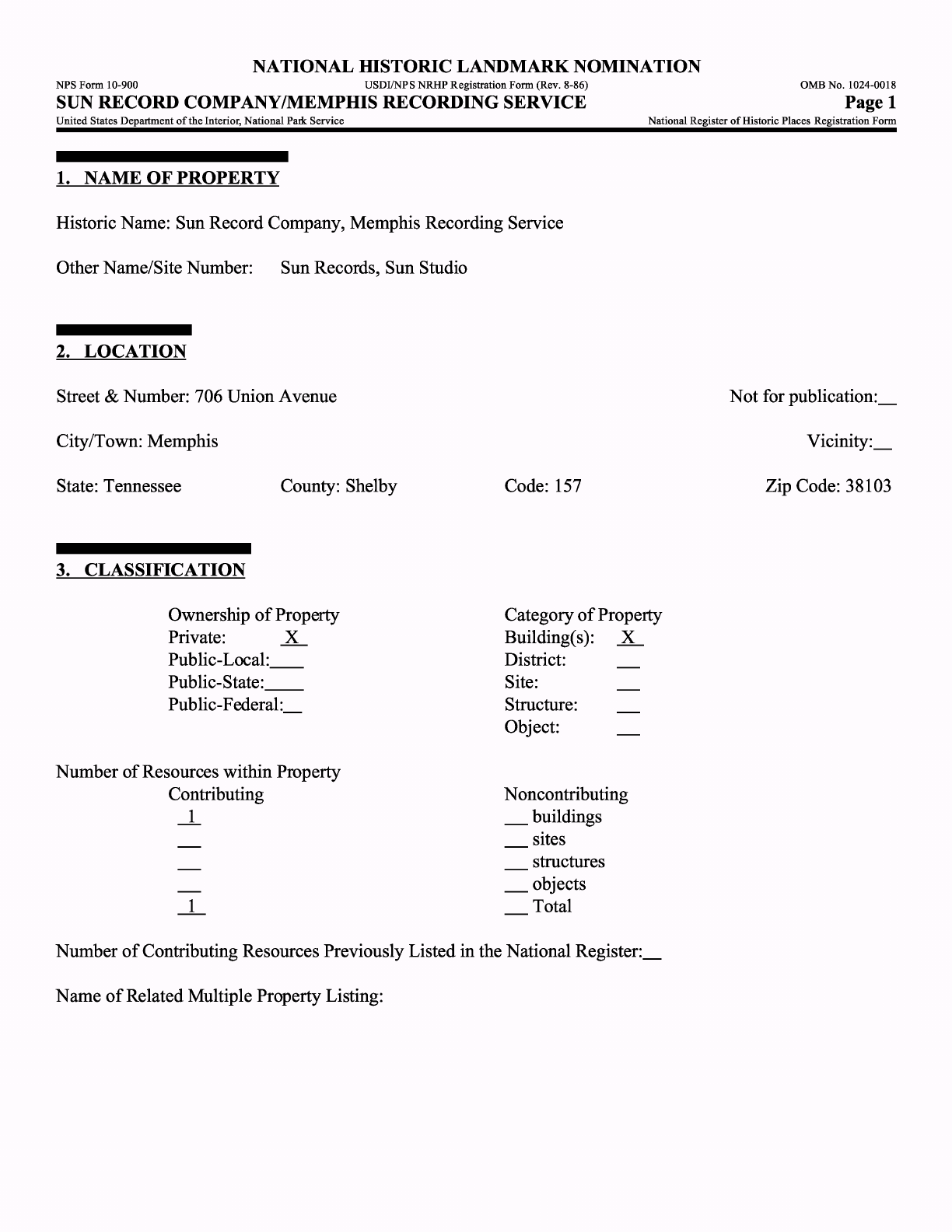
NATIONAL
HISTORIC
LANDMARK NOMINATION
NFS
Form
10-900
USDI/NP
S
NRHP
Registration
Form
(Rev. 8-86)
OMB
No.
1024-0018
SUN
RECORD
COMPANY/MEMPHIS
RECORDING
SERVICE
Page
1
United
States
Department
of
the
Interior,
National
Park
Service
National
Register
of
Historic
Places
Registration
Form
1.
NAME
OF
PROPERTY
Historic
Name:
Sun
Record
Company,
Memphis
Recording
Service
Other
Name/Site
Number:
Sun
Records,
Sun
Studio
2.
LOCATION
Street
&
Number:
706
Union
Avenue
City/Town:
Memphis
State:
Tennessee
County:
Shelby
Code:
157
Not
for
publication:_
Vicinity:_
Zip
Code: 38103
3.
CLASSIFICATION
Ownership
of
Property
Private:
X
Public-Local:__
Public-State:__
Public-Federal:
Number
of
Resources
within
Property
Contributing
1
1
Category
of
Property
Building(s):
X
District:
_
Site:
_
Structure:
_
Object:
_
Noncontributing
_
buildings
_
sites
_
structures
_
objects
Total
Number
of
Contributing Resources
Previously
Listed
in
the
National
Register:_
Name
of
Related
Multiple
Property
Listing:

NFS
Form
10-900
USDI/NPS
NRHP
Registration
Form
(Rev. 8-86)
OMB
No.
1024-0018
SUN
RECORD COMPANY/MEMPHIS
RECORDING
SERVICE
Page
2
United
States
Department
of
the
Interior,
National
Park
Service_____________________________________National
Register
of
Historic
Places
Registration
Form
4.
STATE/FEDERAL AGENCY
CERTIFICATION
As
the
designated
authority
under
the
National
Historic
Preservation
Act
of
1966,
as
amended,
I
hereby
certify
that
this
__
nomination
__
request
for
determination
of
eligibility meets
the
documentation
standards
for
registering
properties
in
the
National
Register
of
Historic Places and
meets
the
procedural
and
professional
requirements
set
forth
in
36
CFR
Part
60.
In
my
opinion,
the
property
__
meets
__
does
not
meet
the
National
Register
Criteria.
Signature
of
Certifying
Official
Date
State
or
Federal
Agency
and
Bureau
In
my
opinion,
the
property
__
meets
__
does
not
meet
the
National
Register
criteria.
Signature
of
Commenting
or
Other
Official
Date
State
or
Federal
Agency
and
Bureau
5.
NATIONAL
PARK
SERVICE
CERTIFICATION
I
hereby
certify
that
this
property
is:
Entered
in
the
National
Register
Determined
eligible
for
the
National
Register
Determined
not
eligible
for
the
National
Register
Removed
from
the
National
Register
Other
(explain):
_________________
Signature
of
Keeper
Date
of
Action

NFS
Form
10-900
USDI/NPS
NRHP
Registration
Form
(Rev. 8-86)
SUN
RECORD COMPANY/MEMPHIS
RECORDING
SERVICE
United
States
Department
of
the
Interior,
National
Park
Service_______________________________
OMBNo.
1024-0018
Page
3
National
Register
of
Historic
Places
Registration
Form
6.
FUNCTION
OR
USE
Historic:
Commerce/Trade
Current:
Recreation
and
Culture
Sub:
Professional
Sub:
Museum
Music
Facility
7.
DESCRIPTION
Architectural
Classification:
No
Style
Materials:
Foundation:
Concrete
Walls:
Brick,
Stone
Roof:
Synthetics
Other:
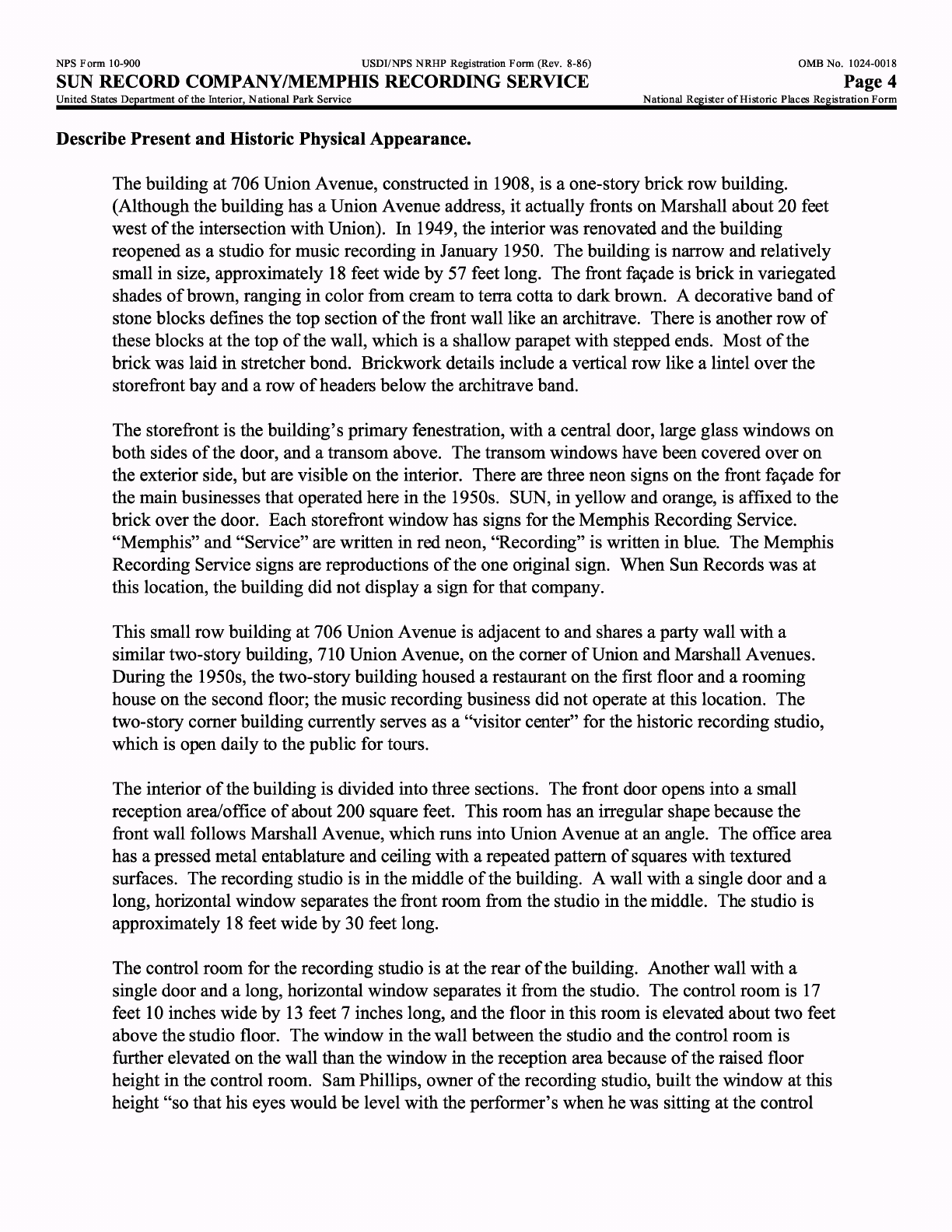
NFS
Form
10-900
USDI/NPS
NRHP
Registration
Form
(Rev. 8-86)
OMB
No.
1024-0018
SUN
RECORD COMPANY/MEMPHIS
RECORDING
SERVICE
Page
4
United
States
Department
of
the
Interior,
National
Park
Service
National
Register
of
Historic
Places
Registration
Form
Describe
Present
and
Historic
Physical
Appearance.
The
building
at
706
Union
Avenue,
constructed
in
1908,
is
a
one-story
brick
row
building.
(Although
the
building
has
a
Union
Avenue
address,
it
actually
fronts
on
Marshall about
20
feet
west
of
the
intersection
with
Union).
In
1949,
the
interior
was
renovated
and
the
building
reopened
as
a
studio
for
music
recording
in
January
1950.
The
building
is
narrow
and
relatively
small
in
size,
approximately
18
feet
wide
by
57
feet
long.
The
front
facade
is
brick
in
variegated
shades
of
brown,
ranging
in
color
from cream
to
terra
cotta
to
dark
brown.
A
decorative band
of
stone
blocks
defines
the
top
section
of
the
front
wall
like
an
architrave.
There
is
another
row
of
these
blocks
at
the
top
of
the
wall,
which
is
a
shallow
parapet
with
stepped
ends.
Most
of
the
brick
was
laid
in
stretcher
bond.
Brickwork
details include
a
vertical
row
like
a
lintel
over
the
storefront
bay
and
a
row
of
headers
below
the
architrave
band.
The
storefront
is
the
building's
primary
fenestration,
with
a
central
door,
large
glass
windows
on
both
sides
of
the
door,
and
a
transom
above.
The
transom
windows have
been
covered
over
on
the
exterior
side,
but
are
visible
on
the
interior.
There
are
three
neon
signs
on
the
front
fa9ade
for
the
main
businesses
that
operated
here
in
the
1950s.
SUN,
in
yellow
and
orange,
is
affixed
to
the
brick
over
the
door.
Each storefront
window
has
signs
for
the
Memphis
Recording
Service.
"Memphis"
and
"Service"
are
written
in
red
neon,
"Recording"
is
written
in
blue.
The
Memphis
Recording
Service
signs
are
reproductions
of
the
one
original
sign.
When
Sun
Records
was
at
this
location,
the
building
did
not
display
a
sign
for
that
company.
This
small
row
building
at
706
Union
Avenue
is
adjacent
to
and
shares
a
party
wall
with
a
similar
two-story
building,
710
Union
Avenue,
on
the
corner
of
Union
and
Marshall
Avenues.
During
the
1950s,
the
two-story building
housed
a
restaurant
on
the
first floor and
a
rooming
house
on
the
second
floor;
the
music
recording
business
did
not
operate
at
this location.
The
two-story
corner
building
currently
serves
as
a
"visitor
center"
for
the
historic
recording
studio,
which
is
open
daily
to
the
public
for
tours.
The
interior
of
the
building
is
divided
into
three
sections.
The
front
door
opens
into
a
small
reception
area/office
of
about
200
square
feet.
This
room
has
an
irregular
shape
because
the
front
wall
follows
Marshall
Avenue,
which
runs
into
Union
Avenue
at
an
angle.
The
office
area
has
a
pressed
metal
entablature
and
ceiling
with
a
repeated
pattern
of
squares
with
textured
surfaces.
The
recording
studio
is
in
the
middle
of
the
building.
A
wall
with
a
single
door
and
a
long,
horizontal
window
separates
the
front
room
from
the studio
in
the
middle.
The
studio
is
approximately
18
feet
wide
by
30
feet
long.
The
control
room
for
the
recording
studio
is
at
the
rear
of
the
building.
Another
wall
with
a
single
door
and
a
long,
horizontal
window
separates
it
from
the
studio.
The
control
room
is
17
feet
10
inches
wide
by
13
feet
7
inches
long,
and
the
floor
in
this
room
is
elevated
about
two
feet
above
the studio
floor.
The
window
in
the
wall
between
the
studio
and
the
control
room
is
further
elevated
on
the
wall
than
the
window
in
the
reception area
because
of
the
raised
floor
height
in
the
control room.
Sam
Phillips,
owner
of
the
recording
studio,
built
the
window
at
this
height
"so
that
his
eyes
would
be
level
with
the
performer's
when
he
was
sitting
at
the
control
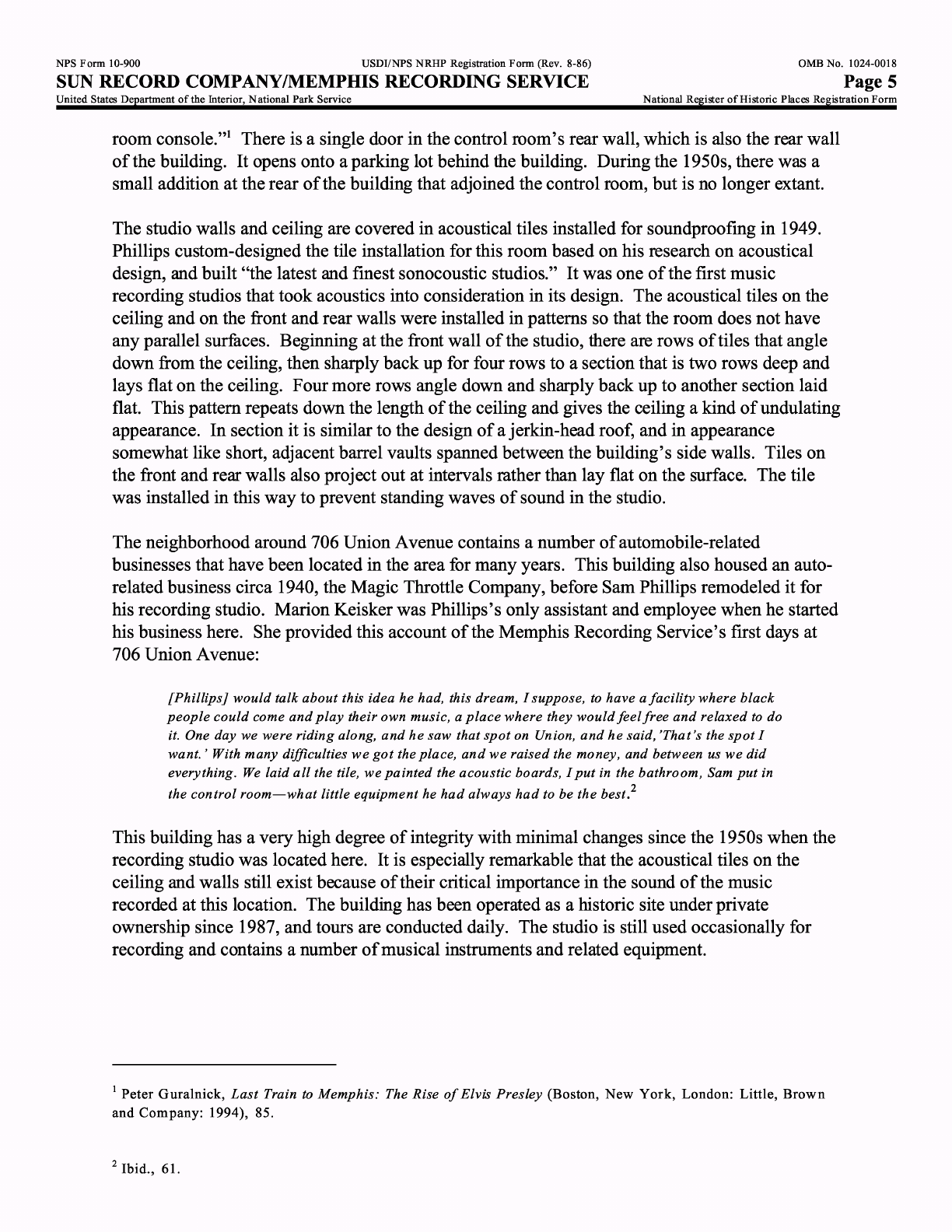
NFS
Form
10-900
USDI/NPS
NRHP
Registration
Form
(Rev. 8-86)
OMB
No.
1024-0018
SUN
RECORD COMPANY/MEMPHIS
RECORDING
SERVICE
Page
5
United
States
Department
of
the
Interior,
National
Park
Service
National
Register
of
Historic
Places
Registration
Form
room
console."
1
There
is
a
single
door
in
the
control
room's
rear
wall,
which
is
also
the
rear
wall
of
the
building.
It
opens
onto
a
parking
lot
behind
the
building.
During
the
1950s,
there
was
a
small
addition
at
the
rear
of
the
building
that
adjoined
the
control
room,
but
is
no
longer
extant.
The
studio
walls and ceiling
are
covered
in
acoustical
tiles
installed
for
soundproofing
in
1949.
Phillips
custom-designed
the
tile
installation
for
this
room
based
on
his
research
on
acoustical
design,
and
built
"the
latest
and
finest
sonocoustic
studios."
It
was
one
of
the
first
music
recording
studios
that
took
acoustics
into
consideration
in
its
design.
The
acoustical
tiles
on
the
ceiling and
on
the
front and
rear
walls
were installed
in
patterns
so
that
the
room
does
not
have
any
parallel
surfaces.
Beginning
at
the
front
wall
of
the
studio,
there
are
rows
of
tiles
that
angle
down
from
the
ceiling,
then
sharply
back
up
for four
rows
to
a
section
that
is
two rows
deep
and
lays
flat on
the
ceiling.
Four
more
rows
angle
down
and
sharply
back
up
to
another
section
laid
flat.
This
pattern
repeats
down
the
length
of
the
ceiling and
gives
the ceiling
a
kind
of
undulating
appearance.
In
section
it
is
similar
to
the
design
of
a
jerkin-head
roof,
and
in
appearance
somewhat
like
short,
adjacent
barrel
vaults
spanned
between
the
building's
side
walls.
Tiles on
the
front
and
rear
walls
also
project
out
at
intervals
rather
than
lay
flat
on
the
surface.
The
tile
was
installed
in
this
way
to
prevent
standing
waves
of
sound
in
the
studio.
The
neighborhood
around
706
Union
Avenue
contains
a
number
of
automobile-related
businesses
that
have
been
located
in
the area
for
many
years.
This
building
also
housed
an
auto-
related
business circa
1940,
the
Magic Throttle
Company,
before
Sam
Phillips
remodeled
it
for
his
recording
studio.
Marion
Keisker
was
Phillips's
only
assistant
and employee
when
he started
his
business
here.
She
provided
this
account
of
the
Memphis
Recording
Service's
first
days
at
706
Union
Avenue:
[Phillips]
would
talk
about
this
idea
he
had,
this
dream,
I
suppose,
to
have
a
facility
where
black
people
could
come
and
play
their
own
music,
a
place
where
they
would
feel
free
and relaxed
to
do
it.
One
day
we
were
riding
along,
and
he
saw that
spot
on
Union,
and
he
said,
'That's
the
spot
I
want.'
With
many
difficulties
we
got
the
place,
and
we
raised
the
money,
and
between
us
we
did
everything.
We
laid
all
the
tile,
we
painted
the
acoustic
boards,
I
put
in
the
bathroom,
Sam
put
in
*y
the
control
room—what
little equipment
he
had
always
had
to
be
the
best.
This
building
has
a
very
high
degree
of
integrity
with
minimal
changes
since
the
1950s
when
the
recording
studio
was
located
here.
It
is
especially
remarkable
that
the
acoustical
tiles
on
the
ceiling
and
walls
still
exist
because
of
their
critical
importance
in
the
sound
of
the
music
recorded
at
this
location.
The
building
has
been
operated
as
a
historic
site
under
private
ownership
since
1987,
and
tours
are
conducted
daily.
The
studio
is
still
used
occasionally
for
recording
and
contains
a
number
of
musical
instruments
and
related
equipment.
1
Peter
Guralnick,
Last
Train
to
Memphis:
The
Rise
of
Elvis
Presley
(Boston, New
York,
London:
Little,
Brown
and
Company:
1994),
85.
Ibid.,
61.
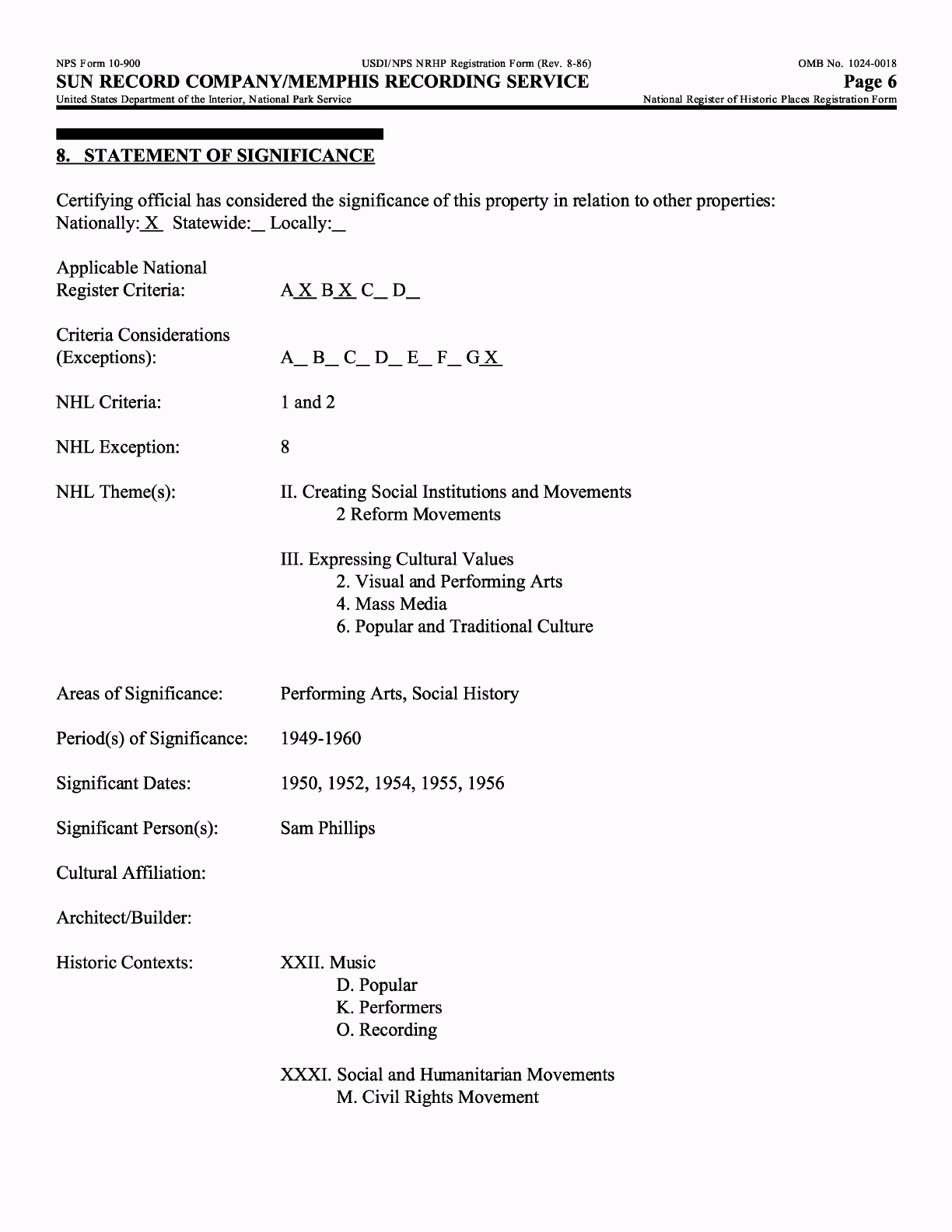
NFS
Form
10-900
USDI/NPS
NRHP
Registration
Form
(Rev. 8-86)
SUN
RECORD COMPANY/MEMPHIS
RECORDING
SERVICE
United
States
Department
of
the
Interior,
National
Park
Service_______________________________
OMBNo.
1024-0018
Page
6
National
Register
of
Historic
Places
Registration
Form
8.
STATEMENT
OF
SIGNIFICANCE
Certifying
official
has
considered
the
significance
of
this
property
in
relation
to
other
properties:
Nationally:
JC.
Statewide:_
Locally:_
Applicable
National
Register
Criteria:
Criteria
Considerations
(Exceptions):
NHL
Criteria:
NHL
Exception:
NHL
Theme(s):
AJL
B
JL
C_
D_
A_
B_
C_
D_
E_
F
1
and
2
II.
Creating
Social
Institutions
and
Movements
2
Reform
Movements
III.
Expressing
Cultural
Values
2.
Visual
and
Performing
Arts
4.
Mass
Media
6.
Popular
and
Traditional
Culture
Areas
of
Significance:
Period(s)
of
Significance:
Significant
Dates:
Significant
Person(s):
Cultural
Affiliation:
Architect/Builder:
Historic
Contexts:
Performing
Arts,
Social
History
1949-1960
1950, 1952,
1954,
1955,
1956
Sam
Phillips
XXII. Music
D.
Popular
K.
Performers
O.
Recording
XXXI.
Social
and
Humanitarian
Movements
M.
Civil
Rights
Movement
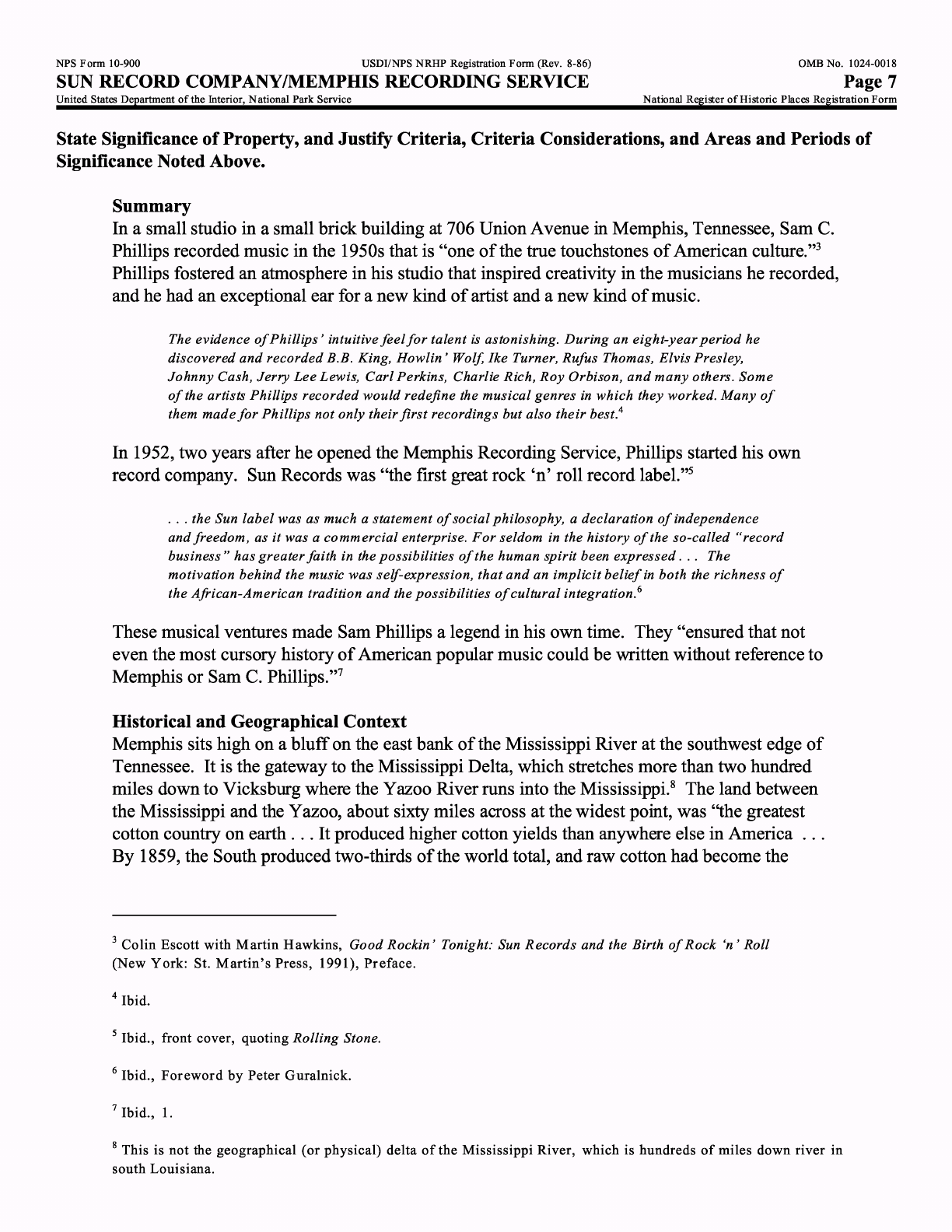
NFS
Form
10-900
USDI/NPS
NRHP
Registration
Form
(Rev. 8-86)
OMB
No.
1024-0018
SUN
RECORD COMPANY/MEMPHIS
RECORDING
SERVICE
Page
7
United
States
Department
of
the
Interior,
National
Park
Service
National
Register
of
Historic
Places
Registration
Form
State
Significance
of
Property,
and
Justify
Criteria,
Criteria
Considerations,
and
Areas
and
Periods
of
Significance Noted
Above.
Summary
In
a
small
studio
in
a
small
brick
building
at
706
Union
Avenue
in
Memphis,
Tennessee,
Sam
C.
Phillips
recorded
music
in
the
1950s
that
is
"one
of
the
true
touchstones
of
American
culture."
3
Phillips
fostered
an
atmosphere
in
his
studio
that
inspired
creativity
in
the
musicians
he
recorded,
and
he
had
an
exceptional
ear
for
a
new
kind
of
artist
and
a
new
kind
of
music.
The
evidence
of
Phillips'
intuitive
feel
for
talent
is
astonishing.
During
an
eight-year
period
he
discovered
and
recorded
B.B.
King,
Howlin'
Wolf,
Ike
Turner,
Rufus
Thomas,
Elvis
Presley,
Johnny
Cash,
Jerry
Lee
Lewis, Carl
Perkins,
Charlie
Rich,
Roy
Orbison,
and
many
others.
Some
of
the
artists
Phillips
recorded
would
redefine
the
musical
genres
in
-which
they
worked.
Many
of
them
made
for
Phillips
not
only
their
first
recordings
but
also
their
best.
4
In
1952,
two
years
after
he
opened
the
Memphis
Recording
Service,
Phillips
started
his
own
record
company.
Sun
Records
was
"the
first
great
rock
'n'
roll
record
label."
5
.
.
.
the
Sun
label
was
as
much
a
statement
of
social
philosophy,
a
declaration
of
independence
and
freedom,
as
it
was
a
commercial
enterprise.
For
seldom
in
the
history
of
the
so-called
"record
business"
has
greater
faith
in
the
possibilities
of
the
human
spirit
been
expressed.
. .
The
motivation
behind
the
music
was
self-expression,
that
and
an
implicit
belief
in
both
the
richness
of
the
African-American
tradition
and
the
possibilities
of
cultural
integration.
6
These
musical
ventures
made
Sam
Phillips
a
legend
in
his
own
time.
They
"ensured
that not
even
the
most
cursory
history
of
American
popular
music could
be
written without reference
to
Memphis
or
Sam
C.
Phillips."
7
Historical
and
Geographical Context
Memphis
sits
high
on
a
bluff
on
the
east
bank
of
the
Mississippi
River
at
the
southwest
edge
of
Tennessee.
It
is
the
gateway
to
the
Mississippi
Delta,
which
stretches
more
than
two
hundred
miles
down
to
Vicksburg
where
the
Yazoo
River
runs
into
the
Mississippi.
8
The
land
between
the Mississippi
and
the
Yazoo,
about
sixty
miles
across
at
the
widest
point,
was
"the
greatest
cotton
country
on
earth
...
It
produced higher
cotton
yields than
anywhere
else in
America
...
By
1859,
the
South
produced
two-thirds
of
the
world
total,
and
raw
cotton
had
become
the
3
Colin
Escott
with
Martin
Hawkins,
Good
Rochin
'
Tonight:
Sun
Records
and
the
Birth
of
Rock
'n
'
Roll
(New
York:
St.
Martin's
Press,
1991),
Preface.
4
Ibid.
5
Ibid.,
front
cover,
quoting
Rolling
Stone.
6
Ibid.,
Foreword
by
Peter
Guralnick.
7
Ibid.,
1.
8
This
is
not
the
geographical
(or
physical)
delta
of
the
Mississippi
River,
which
is
hundreds
of
miles
down
river
in
south
Louisiana.

NFS
Form
10-900
USDI/NPS
NRHP
Registration
Form
(Rev. 8-86)
OMB
No.
1024-0018
SUN
RECORD COMPANY/MEMPHIS
RECORDING
SERVICE
Page
8
United
States
Department
of
the
Interior,
National
Park
Service
National
Register
of
Historic
Places
Registration
Form
principal
export
commodity
of
the
United
States."
9
The
1860
census
documents
that
Mississippi
produced
1,202,507
bales
of
cotton
that
year.
Each
bale
weighed
four
hundred
pounds.
10
After
the
Civil
War,
most
former
slaves
became
sharecroppers.
In
Mississippi,
"the
result
was
an
appalling
paradox:
grinding
agrarian
poverty,
on
some
of
the
richest
soil
in
the
world."
11
Mississippi
was
notorious
for
being
the
worst
state
for
African
Americans
to
live
because
black
people
there
were
at
rock
bottom.
The
experiences
of
poor
blacks
in
the
late
nineteenth
and
early
twentieth
centuries
were
raw
material
for
a
new
kind
of
music,
and
Mississippi
became
the
"birthplace
of
the
blues."
Although
Nashville
has
been
the
capital
of
Tennessee
since
1826,
Memphis
has
long
been
the
unofficial
capital
city
of
this
region—the
capital
of
the
Mississippi
Delta—and
long
known
as
the
"home
of
the
blues."
Musical
Context
The
neighborhood
around
Beale
Street
in Memphis,
south
of
the central
business
district,
became
a
business
and
entertainment center
that
drew
African
Americans
from
throughout
the
South
after
the
Civil
War.
Later
it
became
a
regional
gathering
place
for
Delta
blues
musicians.
12
W.C.
Handy,
"Father
of
the
Blues,"
wrote
the
"Memphis
Blues"
at
Pee
Wee's
Saloon
on
Beale
Street
in
1909.
Handy
himself, however, said
that
most
of
his
blues were adaptations
of
songs
he
learned
as
a
child.
13
Before
World
War
II
most
black
music
was blues,
and
a
lot
of
those
were
country
blues
of
the
Mississippi
Delta, the
raw,
gut-wrenching
folk
music
of
rural
African
Americans.
Black
migration
out
of
the
rural
South
accelerated
during
the
First World
War
and
exploded
after
World
War
II
when
manual
cotton
picking
came
to
an
end.
Synthetic
materials
took
over
the
market
after
the
discovery
of
nylon
in
1939,
and
the
mechanical
cotton
picker,
able
to
do
the
work
of
fifty
people,
arrived
soon
after.
'The
main
musical
result
of
the
great migration
was
the
blues
came
to
town,
and
not
to
any old
town:
to
Memphis,
which
acted
as
the
local
focus
for
migration
from
the
Delta."
14
West
Tennessee's
African
American
musical
traditions
are
quite
different
from
the
country
music
at
the
Grand
Ole
Opry
in
Nashville
and
the
music
of
the
Appalachian
Mountains
in East
Tennessee,
with
roots
in
the
British
Isles.
Memphis
was
the
place
where
there
was
"a
meeting
of
the
musics,"
according
to
Sam
Phillips,
where
all
kinds
of
southern
music
could
be
heard
in
9
Sir
Peter
Hall,
Cities
in
Civilization
(New
York:
Fromm
International,
1998),
554.
10
John
Hebron
Moore,
The
Emergence
of
the
Cotton
Kingdom
in
the
Old
South-west,
Mississippi,
1790-1860
(Baton
Rouge
and
London: Louisiana
State
University
Press,
1988),
xii.
Hall,
Cities
in
Civilization,
555.
12
The
Beale
Street
Historic
District
was
designated
a
National
Historic
Landmark
in
1966.
13
Hall,
Cities
in
Civilization,
565.
14
Ibid.,
574.
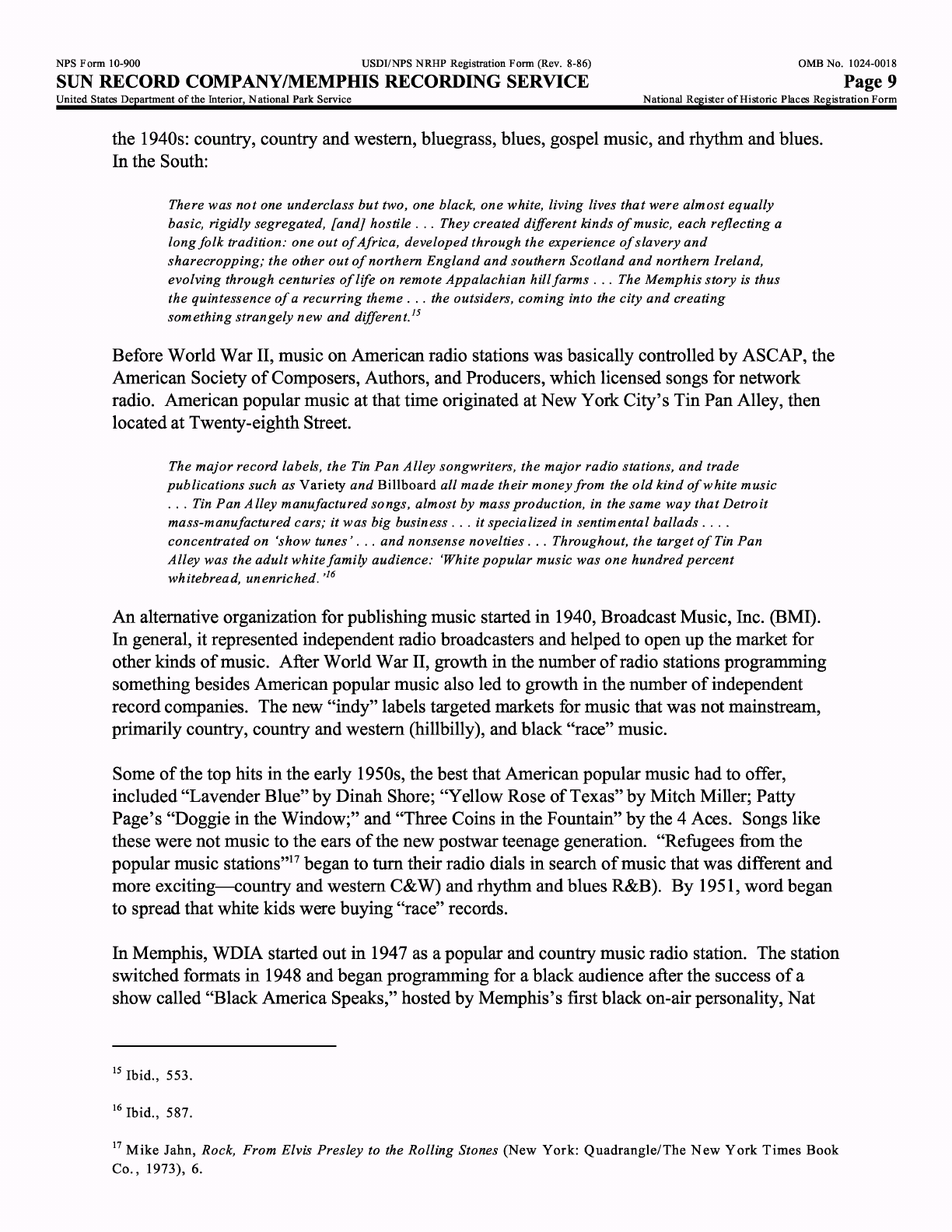
NFS
Form
10-900
USDI/NPS
NRHP
Registration
Form
(Rev. 8-86)
OMB
No.
1024-0018
SUN
RECORD COMPANY/MEMPHIS
RECORDING
SERVICE
Page
9
United
States
Department
of
the
Interior,
National
Park
Service
National
Register
of
Historic
Places
Registration
Form
the
1940s:
country,
country
and western,
bluegrass,
blues,
gospel
music,
and
rhythm
and
blues.
In
the
South:
There
-was
not
one
underclass
but
two,
one
black,
one
white,
living
lives
that
were
almost
equally
basic,
rigidly
segregated,
[and]
hostile
.
..
They
created
different
kinds
of
music,
each
reflecting
a
long
folk
tradition:
one
out
of
Africa,
developed
through
the
experience
of
slavery
and
sharecropping;
the
other
out
of
northern
England
and
southern
Scotland
and
northern
Ireland,
evolving
through
centuries
of
life
on
remote
Appalachian
hill
farms
. . .
The
Memphis
story
is
thus
the
quintessence
of
a
recurring
theme
. . .
the
outsiders,
coming
into
the
city
and
creating
something
strangely
new
and
different.
15
Before
World
War
II,
music
on
American
radio
stations
was
basically
controlled
by
ASCAP,
the
American
Society
of
Composers, Authors,
and
Producers,
which
licensed
songs
for
network
radio.
American
popular
music
at
that
time
originated
at
New
York
City's
Tin
Pan
Alley,
then
located
at
Twenty-eighth
Street.
The
major
record
labels,
the
Tin
Pan
Alley
songwriters,
the
major
radio
stations,
and
trade
publications
such
as
Variety
and
Billboard
all made
their
money
from
the
old kind
of
white
music
.
.
.
Tin
Pan
Alley
manufactured
songs,
almost
by
mass
production,
in
the
same way
that
Detroit
mass-manufactured
cars;
it was
big
business
. . .
it
specialized
in
sentimental
ballads
....
concentrated
on
'show
tunes'.
. .
and
nonsense
novelties
. . .
Throughout,
the
target
of
Tin
Pan
Alley
was
the
adult
white
family
audience:
'White
popular
music
was
one
hundred
percent
whitebread,
unenriched.
'
16
An
alternative
organization
for
publishing
music
started
in
1940,
Broadcast
Music,
Inc.
(BMI).
In
general,
it
represented
independent
radio
broadcasters
and
helped
to
open
up
the
market
for
other
kinds
of
music.
After
World
War
II,
growth
in
the
number
of
radio
stations
programming
something
besides
American
popular
music
also
led
to
growth
in
the
number
of
independent
record
companies.
The
new
"indy"
labels
targeted
markets
for
music
that
was
not
mainstream,
primarily
country,
country
and
western
(hillbilly),
and
black
"race"
music.
Some
of
the
top
hits
in
the
early
1950s,
the
best
that
American
popular
music
had
to offer,
included
"Lavender
Blue"
by
Dinah
Shore;
"Yellow
Rose
of
Texas"
by
Mitch
Miller;
Patty
Page's
"Doggie
in
the
Window;"
and
"Three
Coins
in
the
Fountain"
by
the
4
Aces.
Songs
like
these
were
not
music
to
the
ears
of
the
new
postwar
teenage
generation.
"Refugees
from
the
popular
music
stations"
17
began
to
turn
their
radio
dials
in
search
of
music
that
was
different
and
more
exciting—country
and
western
C&W)
and
rhythm
and
blues
R&B).
By
1951,
word
began
to
spread
that
white
kids
were
buying
"race"
records.
In
Memphis,
WDIA
started
out
in
1947
as
a
popular
and
country music
radio
station.
The
station
switched
formats
in
1948
and
began
programming
for
a
black
audience
after
the
success
of
a
show
called
"Black
America
Speaks,"
hosted
by
Memphis's
first
black
on-air
personality,
Nat
15
Ibid.,
553.
16
Ibid.,
587.
17
Mike
Jahn,
Rock,
From Elvis
Presley
to
the
Rolling
Stones
(New
York:
Quadrangle/The
New
York
Times
Book
Co.,
1973),
6.

NFS
Form
10-900
USDI/NPS
NRHP
Registration
Form
(Rev. 8-86)
OMB
No.
1024-0018
SUN
RECORD COMPANY/MEMPHIS
RECORDING
SERVICE
Page
10
United
States
Department
of
the
Interior,
National
Park
Service
National
Register
of
Historic
Places
Registration
Form
Williams.
Blues
artists
got
exposure
on
WDIA
and
WLOK,
as
well
as
KWEM
across
the
river
in
West
Memphis, Arkansas.
These
stations
sponsored
15-minute
live
shows
daily
featuring
Riley
King
(B.B.
King),
Sonny
Boy
Williamson,
Chester
Burnett
(Howlin'
Wolf),
and
others.
Also
in
1948,
Dewey
Phillips,
a
white
radio
announcer
from
rural
Tennessee,
began
to
host
a
show
on
WHBQ.
"Red
Hot
and
Blue"
expanded
from
fifteen
minutes
to
three
hours
daily during
its
first
year
on
the
air.
Phillips
played
"an
eclectic
mix
of
blues,
hillbilly,
and
pop
that
would
become
an
institution
in
Memphis, and
his
importance
to
the
cross-cultural
miscegenation that
became
Rock
'n'
Roll
is
incalculable."
18
Sam
Phillips,
the
Memphis
Recording
Service,
and
Sun
Record
Company
Sam
Phillips
was
born
on
January
5,
1923
in
the
northwest
corner
of
Alabama
near
Florence,
about
150
miles
east
of
Memphis.
He
got
his
first
radio
job
in
1940
at
WLAY
in
Muscle
Shoals,
Alabama, and
later
took
correspondence
courses
in
radio
engineering.
He
worked
at
WMSL
in
Decatur,
Alabama,
and
at
WLAC
in
Nashville
before
moving
to
Memphis
in
1945.
At
WREC,
Phillips
was
primarily
a
radio
announcer
(the
term
"disc
jockey"
was
coined
in
the
early
1950s),
with
a
daily
show
at
4
P.M.
called "Songs
of
the West."
In
those
days,
radio
engineers
had
multiple
duties.
Phillips
was
also
a
recording
engineer,
in
charge
of
the
station's
sound
effects,
and
buyer
for
the
station's
record
library.
In
addition,
he
was
part
of
the
technical
staff
for
WREC's
nightly
broadcast
on
the
CBS
network
of
touring big
bands
at
the
Skyway,
the
Peabody
Hotel's
rooftop
ballroom.
Sam
Phillips
started
a
show
on
WREC
in
Memphis
in
the
late
1940s
that
was
similar
to
Dewey
Phillips's
"Red
Hot
and
Blue."
He
played
blues, pop,
and
jazz
on
the
"Saturday
Afternoon
Tea
Dance."
In
January
1950,
Phillips
started
his
own
recording
business
in
addition
to
his
regular
jobs.
The
Memphis
Recording
Service
opened
at
706
Union
Avenue,
about
a
mile
east
of
the
downtown
area.
The
small
one-story
brick
building
had
a
reception
area/office
at
the
front
of
the
building,
a
recording
studio
in
the
middle
section,
and
a
small
control
room
in
the
rear. The
entire
building
is
only
about
18
feet
wide and
57
feet
long.
Phillips's
business
card
read
"We
Record
Anything—Anywhere—Anytime."
Initially
that
included
weddings,
funerals,
bar
mitzvahs,
advertisements
for
radio,
etc.,
in
addition
to
musicians
in
his
studio.
In
the last
two decades,
music
historians
have
sought
out
Sam
Phillips
to
document
his
account
of
the
first
years
of
rock
'n'
roll.
He
was
out
of
the
public
eye
for
some
time,
but
Phillips
has
been
more
available
in
recent
years:
/
opened
the
Memphis
Recording
Service
-with
the
intention
of
recording
singers
and
musicians
from
Memphis
and
the
locality
who
I
felt
had
something
that
people should
be
able
to
hear.
I'm
talking
about
blues—both
the
country
style
and
the
rhythm
style—and
also
about
gospel
or
spiritual
music
and
about
white
country
music.
I
always
felt
that
people
who
played
this
type
of
music
had
not
been
given
the
opportunity
to
reach
an
audience
.
. .
My
aim
was
to
try
and
record
the
blues
and
other
music
I
liked
and
to
prove
whether
I
was right
or
wrong
about
this
music.
I
knew,
or
I
felt
I
knew,
that
there
was
a
bigger
audience
for
blues
than
just
the
black
Escott,
Good
Rockin'
Tonight,
5.
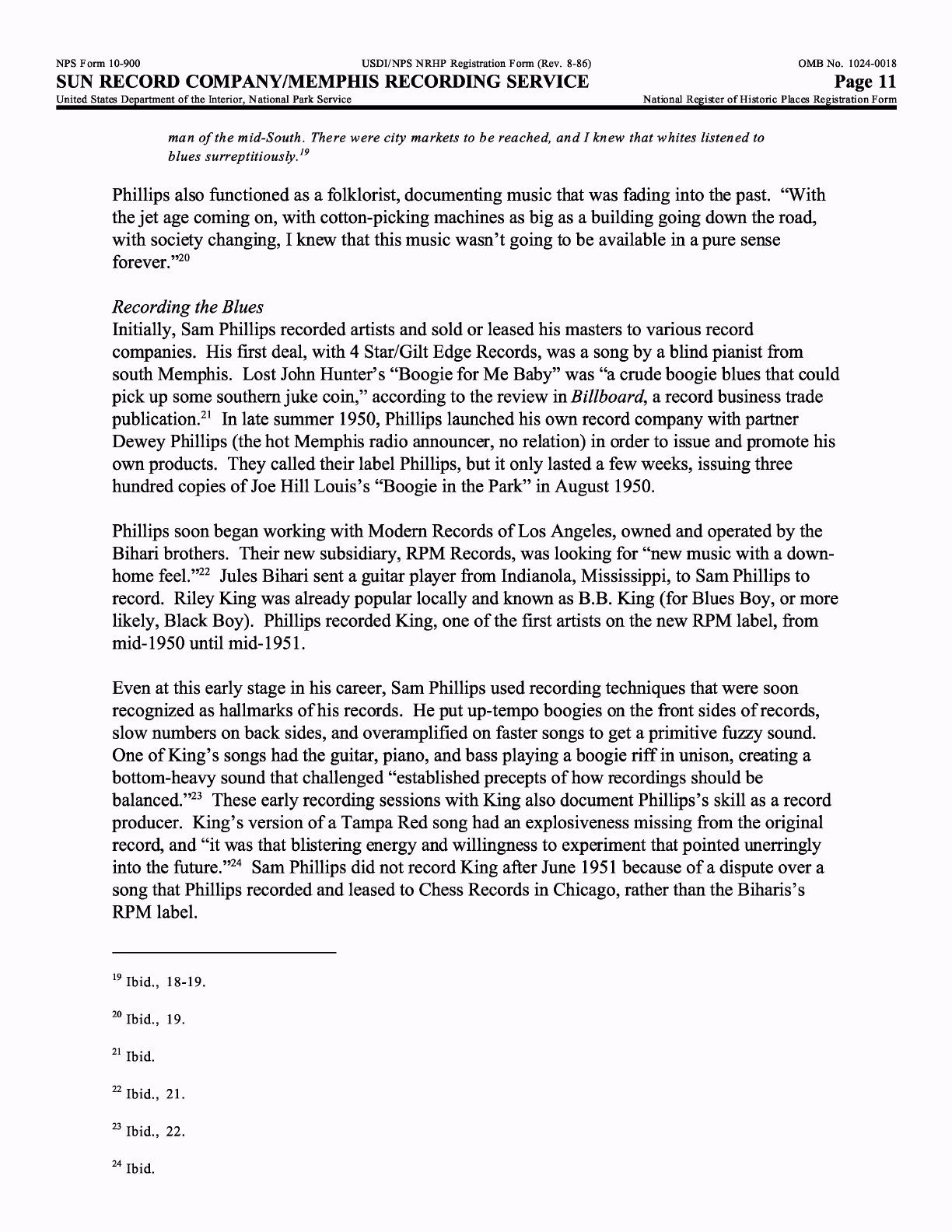
NFS
Form
10-900
USDI/NPS
NRHP
Registration
Form
(Rev. 8-86)
OMB
No.
1024-0018
SUN
RECORD COMPANY/MEMPHIS
RECORDING
SERVICE
Page
11
United
States
Department
of
the
Interior,
National
Park
Service
National
Register
of
Historic
Places
Registration
Form
man
of
the
mid-South.
There
were
city
markets
to
be
reached,
and
I
knew
that
whites
listened
to
blues
surreptitiously.
19
Phillips
also
functioned
as
a
folklorist,
documenting
music
that
was
fading
into
the
past.
"With
the
jet
age
coming
on,
with
cotton-picking
machines
as
big
as
a
building
going
down
the
road,
with
society
changing,
I
knew
that
this
music
wasn't
going
to
be
available
in
a
pure
sense
forever."
20
Recording
the
Blues
Initially,
Sam
Phillips
recorded
artists
and
sold
or
leased
his
masters
to
various
record
companies.
His
first
deal,
with
4
Star/Gilt
Edge
Records,
was
a
song
by
a
blind pianist
from
south
Memphis.
Lost
John
Hunter's
"Boogie
for
Me
Baby"
was
"a
crude
boogie
blues
that
could
pick
up
some
southern
juke
coin,"
according
to
the
review
^Billboard,
a
record
business
trade
publication.
21
In
late
summer
1950,
Phillips
launched
his
own
record
company
with
partner
Dewey
Phillips
(the
hot
Memphis
radio
announcer, no
relation)
in
order
to
issue
and
promote
his
own
products.
They
called
their
label
Phillips,
but
it
only
lasted
a
few
weeks,
issuing three
hundred
copies
of
Joe
Hill
Louis's
"Boogie
in
the
Park"
in
August
1950.
Phillips
soon
began
working with Modern
Records
of
Los
Angeles,
owned
and
operated
by
the
Bihari
brothers.
Their
new
subsidiary,
RPM Records,
was
looking for
"new
music
with
a
down-
home
feel."
22
Jules
Bihari
sent
a
guitar
player
from
Indianola,
Mississippi,
to
Sam
Phillips
to
record.
Riley
King
was
already
popular
locally
and known
as
B.B.
King
(for Blues
Boy,
or
more
likely,
Black
Boy).
Phillips
recorded
King,
one
of
the
first
artists
on
the
new
RPM
label,
from
mid-1950
until
mid-1951.
Even
at
this
early
stage
in
his
career,
Sam
Phillips
used
recording
techniques
that
were
soon
recognized
as
hallmarks
of
his
records. He
put
up-tempo
boogies
on
the
front
sides
of
records,
slow
numbers
on
back
sides,
and
overamplified
on
faster
songs
to
get
a
primitive
fuzzy
sound.
One
of
King's
songs
had
the
guitar,
piano,
and
bass
playing
a
boogie
riff
in
unison,
creating
a
bottom-heavy
sound
that
challenged
"established
precepts
of
how
recordings
should
be
balanced."
23
These
early
recording
sessions
with
King
also
document
Phillips's
skill
as
a
record
producer.
King's
version
of
a
Tampa
Red
song
had
an
explosiveness
missing
from
the
original
record,
and
"it
was
that
blistering
energy
and
willingness
to
experiment
that
pointed
unerringly
into
the
future."
24
Sam
Phillips did
not
record
King after
June
1951
because
of
a
dispute
over
a
song
that
Phillips
recorded
and
leased
to
Chess
Records
in
Chicago,
rather
than
the
Biharis's
RPM
label.
Ibid.,
18-19.
20
Ibid.,
19.
21
Ibid.
22
Ibid.,
21.
23
Ibid.,
22.
Ibid.
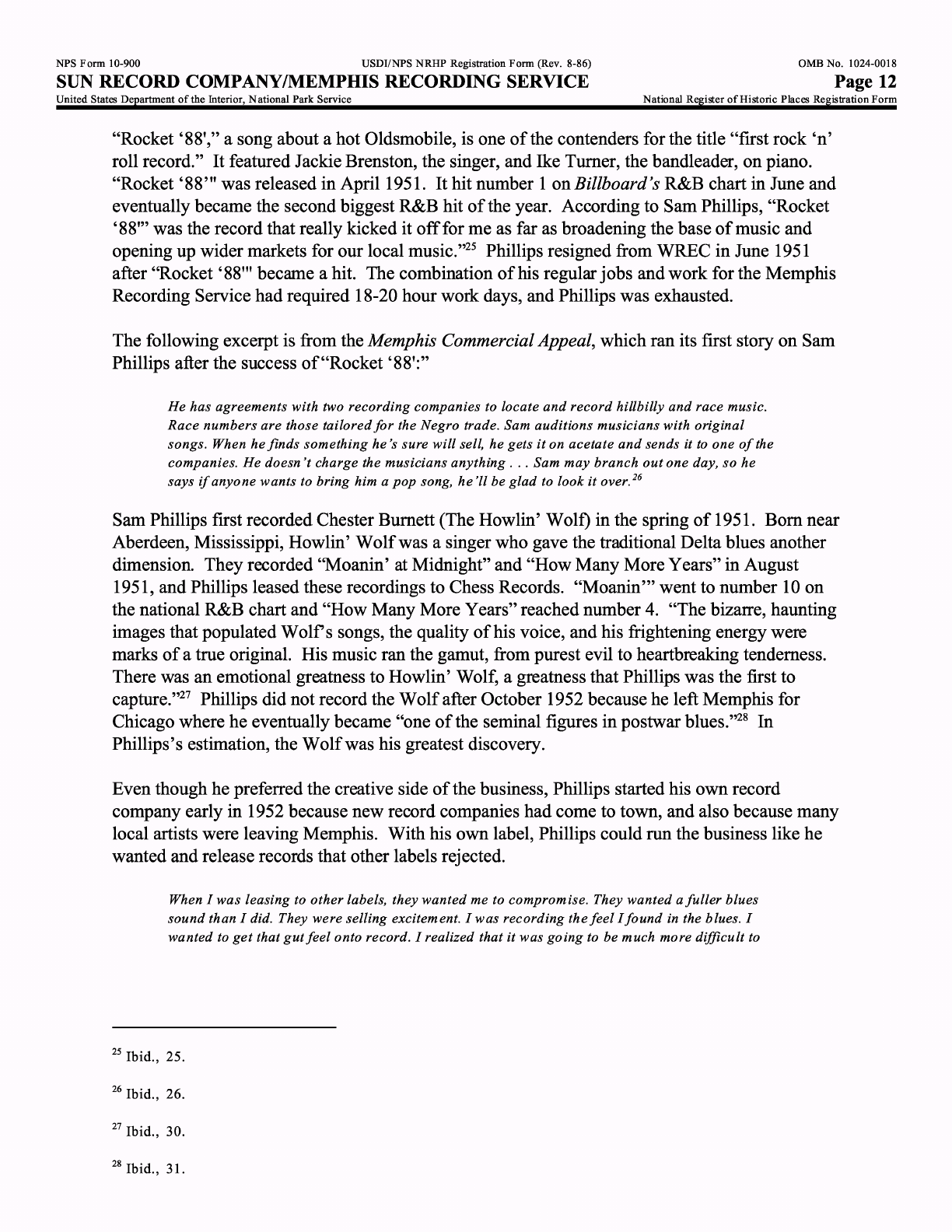
NFS
Form
10-900
USDI/NPS
NRHP
Registration
Form
(Rev. 8-86)
OMB
No.
1024-0018
SUN
RECORD COMPANY/MEMPHIS
RECORDING
SERVICE
Page
12
United
States
Department
of
the
Interior,
National
Park
Service
National
Register
of
Historic
Places
Registration
Form
"Rocket
'88',"
a
song
about
a
hot
Oldsmobile,
is
one
of
the
contenders for
the
title
"first
rock
'n'
roll
record."
It
featured
Jackie
Brenston, the
singer,
and
Ike
Turner,
the
bandleader,
on
piano.
"Rocket
'88'"
was
released
in
April
1951.
It
hit
number
1
on
Billboard's
R&B
chart
in
June
and
eventually
became
the
second
biggest
R&B
hit
of
the
year.
According
to
Sam
Phillips,
"Rocket
'88'"
was
the
record
that
really kicked
it
off
for
me
as
far
as
broadening
the
base
of
music
and
opening
up
wider
markets for our
local
music."
25
Phillips
resigned
from
WREC
in
June
1951
after "Rocket
'88'"
became
a
hit.
The
combination
of
his
regular
jobs
and
work
for
the
Memphis
Recording
Service
had
required
18-20
hour
work
days,
and Phillips
was
exhausted.
The
following
excerpt
is
from
the
Memphis
Commercial
Appeal,
which
ran
its
first
story
on
Sam
Phillips
after the
success
of
"Rocket
'88':"
He
has
agreements
with
two
recording
companies
to
locate
and
record
hillbilly
and
race
music.
Race
numbers
are
those
tailored
for
the
Negro
trade.
Sam
auditions
musicians
with
original
songs.
When
he
finds
something
he's
sure
will
sell,
he
gets
it
on
acetate
and
sends
it
to
one
of
the
companies.
He
doesn
't
charge
the
musicians
anything
. . .
Sam
may
branch
out
one
day,
so
he
says
if
anyone wants
to
bring
him
a
pop
song,
he'll
be
glad
to
look it
over.
26
Sam
Phillips first
recorded
Chester
Burnett
(The
Howlin'
Wolf)
in
the
spring
of
1951.
Born
near
Aberdeen, Mississippi,
Howlin'
Wolf
was
a
singer
who
gave
the
traditional
Delta
blues
another
dimension.
They
recorded
"Moanin'
at
Midnight"
and
"How
Many
More
Years"
in
August
1951,
and
Phillips leased
these
recordings
to
Chess
Records.
"Moanin"'
went
to
number
10
on
the
national
R&B
chart
and
"How
Many
More
Years"
reached
number
4.
"The
bizarre,
haunting
images
that
populated
Wolfs
songs,
the
quality
of
his
voice,
and
his
frightening
energy
were
marks
of
a
true
original.
His
music
ran
the
gamut,
from
purest
evil
to
heartbreaking
tenderness.
There
was
an
emotional
greatness to
Howlin'
Wolf,
a
greatness
that
Phillips
was
the
first
to
capture."
27
Phillips
did
not
record
the
Wolf
after
October
1952
because
he
left
Memphis
for
Chicago
where
he
eventually
became
"one
of
the
seminal
figures
in
postwar
blues."
28
In
Phillips's
estimation, the
Wolf
was
his
greatest
discovery.
Even
though
he
preferred
the
creative
side
of
the
business,
Phillips
started
his
own
record
company
early in
1952
because
new
record
companies
had
come
to
town,
and
also
because
many
local artists
were leaving
Memphis.
With
his
own
label,
Phillips
could
run
the
business
like
he
wanted
and
release
records
that
other
labels
rejected.
When
I
was
leasing
to
other
labels,
they
wanted
me
to
compromise.
They
wanted
a
fuller
blues
sound
than
I
did.
They
were
selling
excitement.
I
was
recording
the
feel
I
found
in
the
blues.
I
wanted
to
get
that
gut
feel
onto
record.
I
realized
that
it
was
going
to
be
much more
difficult
to
25
Ibid.,
25.
26
Ibid.,
26.
27
Ibid.,
30.
Ibid.,
31.

NFS
Form
10-900
USDI/NPS
NRHP
Registration
Form
(Rev. 8-86)
OMB
No.
1024-0018
SUN
RECORD COMPANY/MEMPHIS
RECORDING
SERVICE
Page
13
United
States
Department
of
the
Interior,
National
Park
Service
National
Register
of
Historic
Places
Registration
Form
merchandise
than
-what
Atlantic
or
Specialty,
for
example,
were
doing,
but
I
was
willing
to
go
with
it.
29
He
named
his
new
company
Sun
Records
and
selected
an
eye-catching
record
label
of
primary
yellow,
highlighted
in
brown.
At
the
center
of
the
label
stood
a
crowing
rooster
in
profile
before
a
rising
sun
motif,
with
stylized
sun
rays
fanned
from
one
horizon
to
the
other.
SUN
was
written
in
large
block
letters
over
the
rooster, and
musical
notes
on
a
staff
ringed
the outside
edge
of
the
label.
Phillips
thoughtfully
chose
the
name
Sun
and
its
distinctive
label
design:
'The
sun
to
me—even
as
a
kid
back
on
the
farm—was
a
universal
kind
of
thing.
A
new
day,
a
new
opportunity."
30
The
first
record
issued
on
the
new
Sun
label
(March
27,
1952),
Sun
number
175,
was
an
original
instrumental,
"Drivin'
Slow,"
by
alto
saxophonist
Johnny
London.
Even
on
this
first
release,
all
the
hallmarks
of
a
Sam
Phillips
Sun
record
-were
in
place:
the
raw
sound,
the
experimental
origin,
the
dark
texture,
even
the
trademark
echo.
Phillips
and
London
created
the
illusion
of
a
sax
heard
down
a
long
hallway
on
a
humid
night
by
rigging
something
like
a
telephone
booth
over
London's
head
while
he
played.
The
record's
appeal
had
more
to
do
with
feeling
than
virtuosity—in
short,
it
offered
everything
music
buyers
could
expect
from
Sun
for
the
remainder
of
the
decade?
1
The
first
recording
on
the
Sun
label
considered
to
be
a
classic
was
"Easy,"
an
instrumental
released
in
March
1953
by
Walter
Horton
(Little
Walter,
and
later,
Big
Walter).
. . .
Horton
played
the
same
theme
five
times,
with
mounting
intensity.
By
the
fourth
chorus,
he
was
playing
with
such
intensity
that
his
harmonica
sounded
like
a
tenor
saxophone.
Phillips'
virtuosity
with
tape
delay
echo
was
rarely
used
to
better
advantage:
he
made
three
instruments
[harmonica,
guitar,
drums]
sound
as
full
as
an
orchestra.
Any
other
instrument
would
have
been
redundant.
32
Sun
Records
had
its first
national
hit
in
the
spring
of
1953
with
"Bear
Cat,"
which
went
to
number
3
on
the
national
R&B
chart.
It
was
an
"answer
song"
to
"Hound
Dog"
by
Big
Mama
Thornton
(Willie Mae
Thornton),
sung
by
local
radio
announcer
Rufus
Thomas.
"Bear
Cat"
was
the
first
record
to
make
money
for
Sun
Records
and
it
put
the
company
on
the
map.
"Feelin'
Good,"
by
Little
Junior's
Blue
Flames
(released
in
July
1953),
was
also
commercially
successful,
reaching
number
5
on
the
national
R&B
chart.
Sun's
next
hit
was
"Just
Walkin'
in
the
Rain" by
The
Prisonaires,
a
black
vocal
group
of
five
inmates
from
the
Tennessee
State
Penitentiary
in
Nashville.
They
sang
close-harmony
gospel
style
and
came
under
armed
guard
to
record
at
706
Union
on
June
1,
1953.
As
part
of
the
warden's
rehabilitation
program,
they
were
allowed
to
perform
on
radio,
in
concerts,
and
at
the
Governor's
mansion,
but
"Just
Walkin'
in
the
Rain"
was
their
only
hit.
29
Ibid.,
40.
30
Ibid.,
35.
31
Ibid.,
36-37.
Ibid.,
38-39.
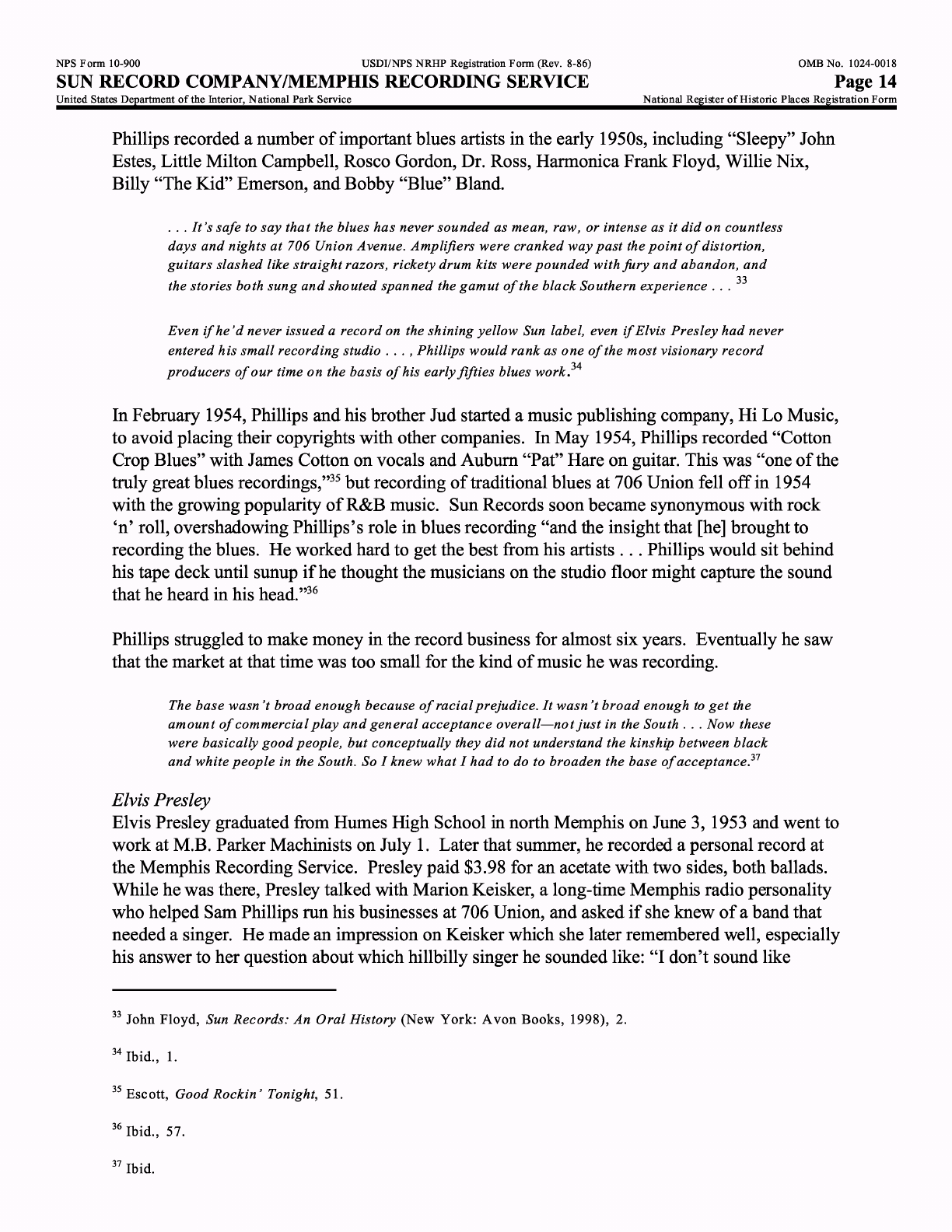
NFS
Form
10-900
USDI/NPS
NRHP
Registration
Form
(Rev. 8-86)
OMB
No.
1024-0018
SUN
RECORD COMPANY/MEMPHIS
RECORDING
SERVICE
Page
14
United
States
Department
of
the
Interior,
National
Park
Service
National
Register
of
Historic
Places
Registration
Form
Phillips
recorded
a
number
of
important blues
artists
in
the early
1950s,
including
"Sleepy"
John
Estes,
Little
Milton
Campbell,
Rosco
Gordon,
Dr.
Ross,
Harmonica
Frank
Floyd,
Willie
Nix,
Billy
"The
Kid"
Emerson,
and
Bobby
"Blue"
Bland.
. .
.
It's
safe
to
say
that
the
blues
has never
sounded
as
mean,
raw,
or
intense
as
it
did
on
countless
days
and
nights
at
706
Union
Avenue.
Amplifiers
were
cranked
way
past
the
point
of
distortion,
guitars
slashed
like
straight
razors,
rickety
drum
kits
were
pounded
with
Jury
and
abandon,
and
the
stories
both
sung
and
shouted
spanned
the
gamut
of
the
black
Southern
experience
. . .
Even
if
he'd
never
issued
a
record
on
the
shining
yellow
Sun
label,
even
ifElvis
Presley
had never
entered
his
small
recording
studio
. . .
,
Phillips
would
rank
as
one
of
the
most
visionary
record
producers
of
our
time
on
the
basis
of
his
early
fifties
blues
work.
In
February
1954,
Phillips and
his
brother
Jud
started
a
music
publishing
company,
Hi
Lo
Music,
to
avoid
placing
their
copyrights
with
other
companies.
In
May
1954,
Phillips
recorded
"Cotton
Crop
Blues"
with
James
Cotton
on
vocals and
Auburn
"Pat"
Hare
on
guitar.
This
was
"one
of
the
truly
great
blues
recordings,"
35
but
recording
of
traditional
blues
at
706
Union
fell
off
in
1954
with
the
growing
popularity
of
R&B
music.
Sun
Records
soon
became
synonymous
with
rock
'n'
roll,
overshadowing
Phillips's
role
in
blues
recording
"and
the
insight
that
[he]
brought
to
recording
the
blues.
He
worked hard
to
get
the
best from
his
artists
...
Phillips
would
sit
behind
his
tape
deck
until
sunup
if
he
thought
the
musicians
on
the
studio
floor
might
capture
the
sound
that
he
heard
in
his
head."
36
Phillips
struggled
to
make
money
in
the
record
business
for almost
six
years.
Eventually
he
saw
that
the
market
at
that
time
was
too
small
for
the
kind
of
music he
was recording.
The
base
wasn
't
broad enough
because
of
racial
prejudice.
It
wasn
't
broad
enough
to
get
the
amount
of
commercial
play
and general
acceptance
overall—not
just
in
the
South
. . .
Now
these
were
basically
good
people,
but
conceptually
they
did
not
understand
the
kinship between
black
and
white
people
in
the
South.
So
I
knew
what
I
had
to
do
to
broaden
the
base
of
acceptance.
37
Elvis
Presley
Elvis
Presley
graduated
from
Humes
High School
in
north
Memphis
on
June
3,
1953
and
went
to
work
at
M.B.
Parker
Machinists
on
July
1.
Later
that
summer,
he
recorded
a
personal
record
at
the
Memphis
Recording
Service.
Presley
paid
$3.98
for
an
acetate
with
two
sides,
both
ballads.
While
he
was
there,
Presley
talked
with
Marion
Keisker,
a
long-time
Memphis
radio
personality
who
helped
Sam
Phillips
run
his
businesses
at
706
Union, and
asked
if
she
knew
of
a
band that
needed
a
singer.
He
made
an
impression
on
Keisker which
she
later
remembered
well,
especially
his
answer
to
her
question about
which
hillbilly
singer
he
sounded
like:
"I
don't
sound
like
33
John
Floyd,
Sun
Records:
An
Oral
History
(New
York:
Avon
Books,
1998),
2.
34
Ibid.,
1.
35
Escott,
Good
Rockin'
Tonight,
51.
36
Ibid.,
57.
37
Ibid.

NFS
Form
10-900
USDI/NPS
NRHP
Registration
Form
(Rev. 8-86)
OMB
No.
1024-0018
SUN
RECORD COMPANY/MEMPHIS
RECORDING
SERVICE
Page
15
United
States
Department
of
the
Interior,
National
Park
Service
National
Register
of
Historic
Places
Registration
Form
nobody."
38
At
that
time,
Presley
had
a
child's
guitar
that
he
played
in
the
park,
on
his
porch
steps,
and
in
a
band
with
his
buddies around
their
housing
project.
He
soon
aspired
to
be
a
member
of
the
Songfellows,
an
amateur
church
quartet.
Presley dropped
by
706
Union
a
number
of
times after
that
initial
meeting
to
see
if
Ms.
Keisker
had
any
leads for
him.
In
January
1954,
Presley
paid
for
a
second
personal
record,
and
tried
out
for
a
professional
band
that
spring.
Eddie
Bond,
the
band
leader,
told him
to
keep
driving
a
truck
because
he
would
never
make
it
as
a singer.
Presley
later
revealed
that
Bond's
rejection
"broke
my
heart."
39
.
.
.
There
is
little
question
that
he
stepped
through the
doorway
[at
706
Union]
with
the
idea,
if
not
of
stardom
. . .
at
the
very
least
of
being
discovered.
In
later
years
he
would
always
say
that
he
wanted
to
make
a
personal
record
"to
surprise
my
mother.
"
Or
"I
just
wanted
to
hear
what
I
sounded
like.
"
But,
of
course,
if
he
had
simply
wanted
to
record
his
voice,
he
could
have
paid
twenty-five
cents
at
W.
T.
Grant's
on
Main
Street.
.
.
Instead,
Elvis
went
to
a
professional
facility,
where
a
man
who
had
been
written
up
in
the
papers
would
hear
him
sing.
40
Marion
Keisker
finally
called
Presley
on
Saturday,
June
26
to
set
up
an
appointment,
almost
a
year
after
he
recorded
his
first
personal
disc.
On
a
recent
trip
to
Nashville, Phillips
had
gotten
an
acetate
of
a
song
that
reminded
him
of
Presley's
voice.
They
worked
on
"Without
You"
for
a
long
time
that
afternoon,
and
Phillips
had
Presley
sing
a
number
of
other
songs
after
his
unsuccessful
attempts
with
"Without
You."
A
week
later,
Phillips
set
Presley
up
with
two
members
of
the
Starlite
Wranglers,
Scotty
Moore
(guitar)
and
Bill
Black
(bass),
and
the three
of
them
went
to
the
studio
on
Monday,
July
5
so
Phillips
could
hear
them
on
tape.
Nothing
special
happened
at
the
session
until
they
took
a
break
and
Presley
began
fooling
around
and
playing
an
old
blues
song
by
Arthur
Crudup,
"That's
All
Right
[Mama]."
Sam
recognized
it
right
away.
He
was
amazed
that
the
boy
even
knew
Arthur
"Big
Boy"
Crudup—nothing
in
any
of
the
songs
he
had
tried
so
far
gave
any
indication
that
he
was
drawn
to
this
kind
of
music
at
all.
But
this
was
the
sort
of
music
that
Sam
had
long
ago
wholeheartedly
embraced
.
. .
And
the
way
the
boy
performed
it,
it
came
across
with
a
freshness
and
an
exuberance,
it
came
across
with
the
kind
of
clear-eyed,
unabashed
originality
that
Sam
sought
in
all
the
music
that
he
recorded—it
was
"different,
"
it
was
itself.*
1
Phillips
got
his
friend
and kindred
spirit,
disc
jockey
Dewey
Phillips,
to
play
"That's
All Right"
on
his
radio
show
"Red
Hot
and
Blue," then
near
the
height
of
its
popularity.
The
response
was
immediate—hundreds
of
phone
calls
and
telegrams.
Dewey
played
the
song
a
number
of
times
that
night
and
also
interviewed Presley
during
the
show.
By
the
time
the
record
was
pressed
and
ready
for
release,
there
were
6,000
orders for
it
locally.
42
Sun
record
number
209
was
released
38
Guralnick,
Last
Train,
63.
39
Ibid.,
83.
40
Ibid.,
62-63.
41
Ibid.,
95.
Ibid.,
104.
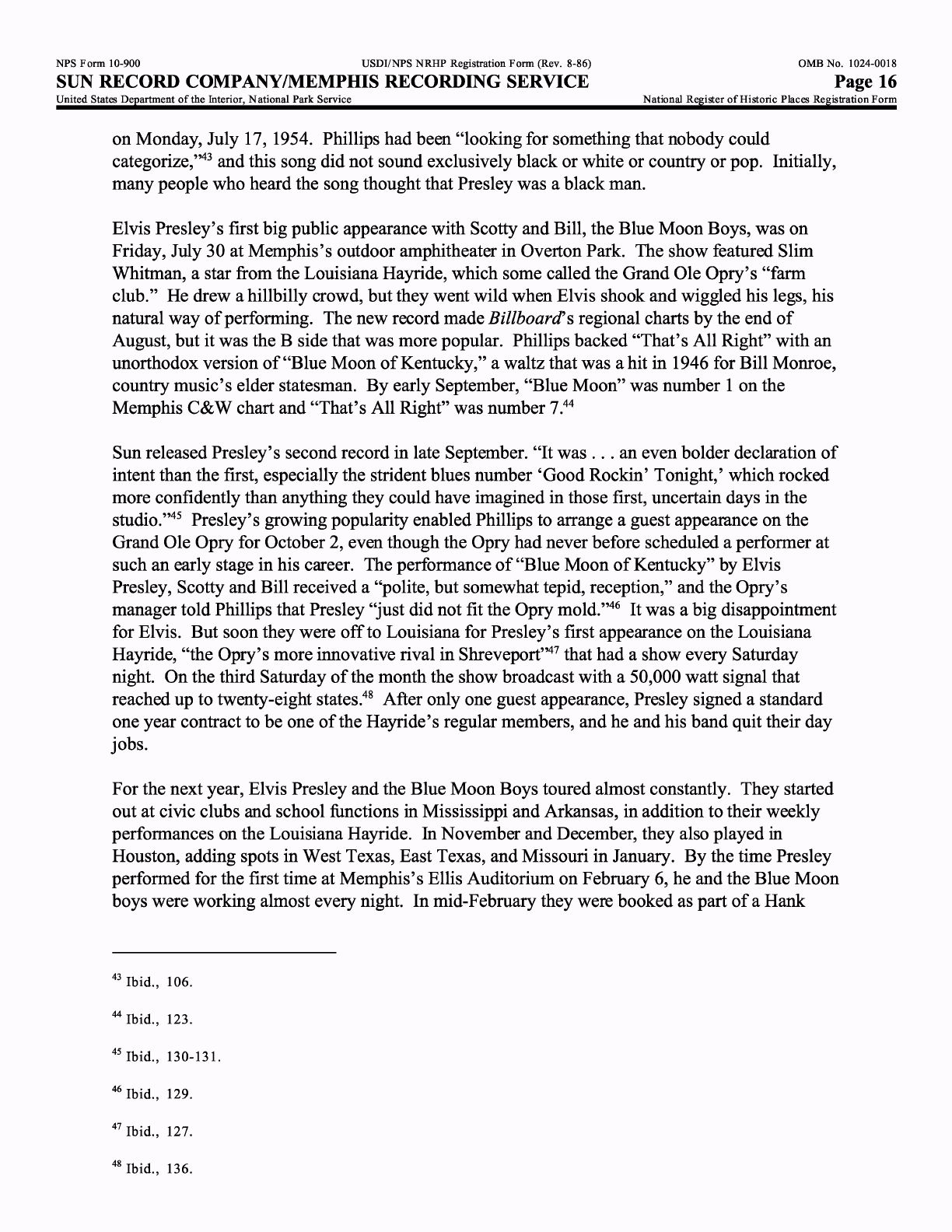
NFS
Form
10-900
USDI/NPS
NRHP
Registration
Form
(Rev. 8-86)
OMB
No.
1024-0018
SUN
RECORD COMPANY/MEMPHIS
RECORDING
SERVICE
Page
16
United
States
Department
of
the
Interior,
National
Park
Service
National
Register
of
Historic
Places
Registration
Form
on
Monday,
July
17,
1954.
Phillips
had
been
"looking
for
something
that
nobody
could
categorize,"
43
and this
song
did
not
sound exclusively
black
or
white
or
country
or
pop.
Initially,
many
people
who
heard
the
song
thought
that
Presley
was
a
black
man.
Elvis
Presley's
first
big
public
appearance
with
Scotty
and
Bill,
the
Blue
Moon
Boys,
was
on
Friday,
July
30
at
Memphis's
outdoor
amphitheater
in Overton
Park.
The
show
featured
Slim
Whitman,
a
star
from
the
Louisiana
Hayride,
which
some called
the
Grand
Ole
Opry's
"farm
club."
He
drew
a
hillbilly
crowd,
but
they
went
wild
when
Elvis
shook
and wiggled
his
legs,
his
natural
way
of
performing.
The
new
record
made
Billboard's
regional
charts
by
the
end
of
August,
but
it
was
the
B
side
that
was
more
popular.
Phillips
backed
"That's
All
Right"
with
an
unorthodox
version
of
"Blue
Moon
of
Kentucky,"
a
waltz
that
was
a
hit
in
1946
for
Bill
Monroe,
country
music's
elder
statesman.
By
early
September,
"Blue
Moon"
was
number
1
on
the
Memphis
C&W
chart
and
"That's
All
Right"
was
number
7.
44
Sun
released
Presley's
second
record
in
late
September.
"It
was
...
an
even
bolder
declaration
of
intent
than
the
first,
especially
the
strident
blues
number
'Good
Rockin'
Tonight,'
which
rocked
more
confidently
than
anything
they could
have
imagined
in
those
first,
uncertain
days
in
the
studio."
45
Presley's
growing
popularity
enabled
Phillips
to
arrange
a
guest
appearance
on
the
Grand
Ole
Opry
for
October
2,
even
though
the
Opry
had
never
before
scheduled
a
performer
at
such
an
early
stage
in
his
career.
The
performance
of
"Blue
Moon
of
Kentucky"
by
Elvis
Presley,
Scotty
and
Bill
received
a
"polite,
but
somewhat
tepid,
reception,"
and
the
Opry's
manager
told
Phillips
that
Presley
"just
did
not
fit
the
Opry
mold."
46
It
was
a
big disappointment
for
Elvis.
But
soon
they
were
off
to
Louisiana
for
Presley's
first
appearance
on
the
Louisiana
Hayride,
"the
Opry's
more
innovative
rival
in
Shreveport"
47
that
had
a
show
every
Saturday
night.
On the
third
Saturday
of
the
month
the
show
broadcast
with
a
50,000
watt
signal
that
reached
up
to
twenty-eight
states.
48
After
only
one
guest
appearance,
Presley
signed
a
standard
one
year
contract
to
be
one
of
the
Hayride's
regular
members,
and
he
and
his
band
quit
their
day
jobs.
For
the
next
year,
Elvis
Presley
and
the
Blue
Moon
Boys
toured
almost
constantly.
They
started
out
at
civic
clubs
and
school
functions
in
Mississippi
and
Arkansas,
in
addition
to
their
weekly
performances
on
the
Louisiana
Hayride.
In
November
and
December,
they
also
played
in
Houston,
adding
spots
in
West
Texas,
East
Texas,
and
Missouri
in
January.
By
the
time
Presley
performed
for
the
first time
at
Memphis's
Ellis
Auditorium
on
February
6,
he
and
the
Blue
Moon
boys
were
working
almost
every
night.
In
mid-February
they
were
booked
as
part
of
a
Hank
Ibid.,
106.
44
Ibid.,
123.
45
Ibid.,
130-131.
46
Ibid.,
129.
47
Ibid.,
127.
Ibid.,
136.
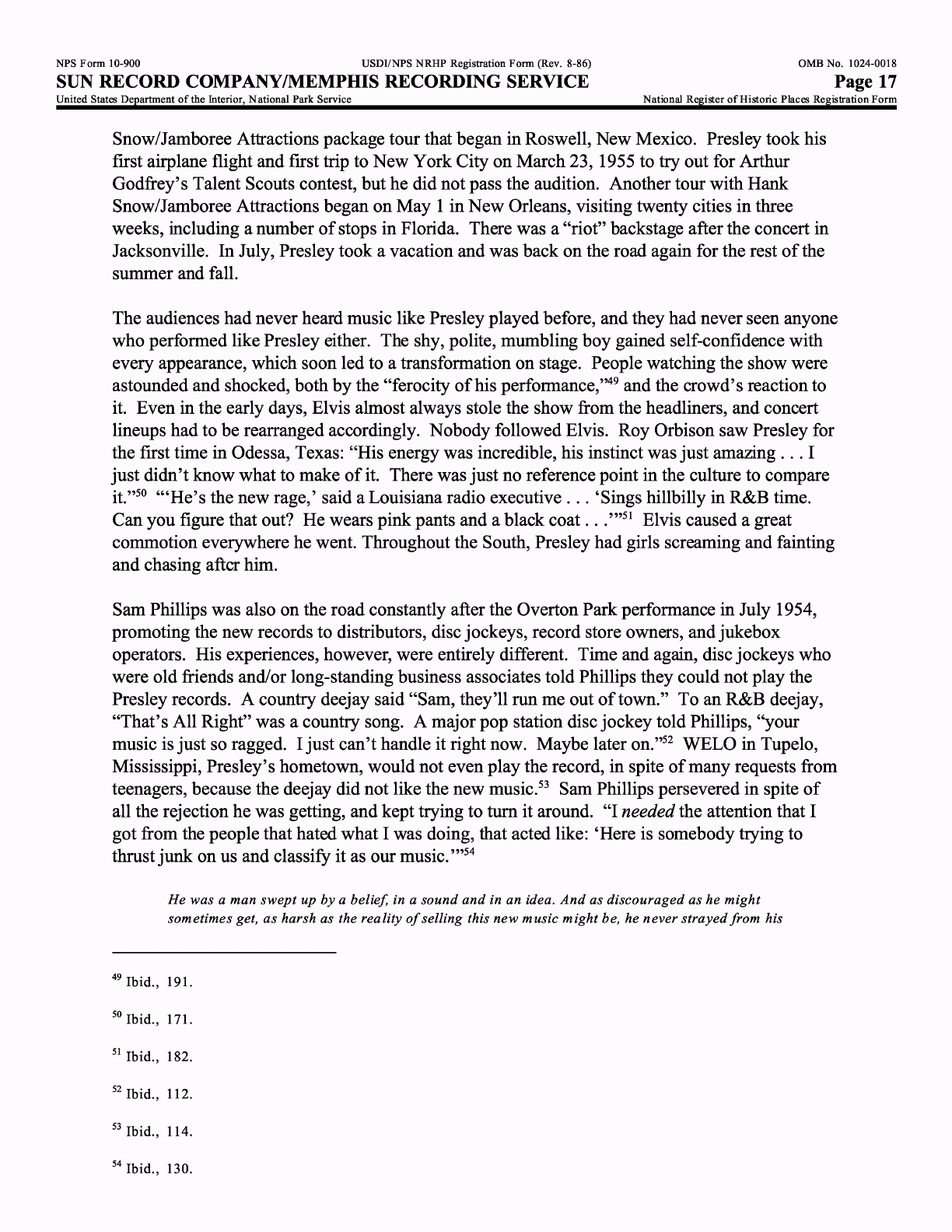
NFS
Form
10-900
USDI/NPS
NRHP
Registration
Form
(Rev. 8-86)
OMB
No.
1024-0018
SUN
RECORD COMPANY/MEMPHIS
RECORDING
SERVICE
Page
17
United
States
Department
of
the
Interior,
National
Park
Service
National
Register
of
Historic
Places
Registration
Form
Snow/Jamboree
Attractions
package
tour
that
began
in
Roswell,
New
Mexico.
Presley
took
his
first
airplane flight
and
first
trip
to
New
York
City
on
March
23,
1955
to
try
out
for
Arthur
Godfrey's
Talent
Scouts
contest,
but
he did
not
pass
the
audition.
Another
tour
with Hank
Snow/Jamboree
Attractions
began
on
May
1
in
New
Orleans,
visiting
twenty
cities
in
three
weeks, including
a
number
of
stops
in
Florida.
There
was
a
"riot"
backstage
after
the
concert
in
Jacksonville.
In
July,
Presley
took
a
vacation
and
was
back
on
the
road
again
for
the
rest
of
the
summer
and
fall.
The
audiences
had
never
heard
music
like
Presley
played
before,
and
they
had
never
seen
anyone
who
performed
like
Presley
either. The
shy,
polite,
mumbling
boy
gained
self-confidence
with
every
appearance, which
soon
led
to
a
transformation
on
stage.
People
watching
the
show
were
astounded
and
shocked,
both
by
the
"ferocity
of
his
performance,"
49
and
the
crowd's
reaction
to
it.
Even
in
the
early
days,
Elvis
almost
always
stole
the
show
from
the
headliners,
and
concert
lineups
had
to
be
rearranged
accordingly.
Nobody
followed
Elvis.
Roy
Orbison
saw
Presley
for
the
first time
in
Odessa,
Texas:
"His energy
was incredible,
his
instinct
was
just
amazing
...
I
just
didn't
know
what
to
make
of
it.
There was
just
no
reference
point
in
the
culture
to
compare
it."
50
'"He's
the
new
rage,'
said
a
Louisiana
radio executive
.
..
'Sings
hillbilly
in
R&B
time.
Can
you
figure
that
out?
He
wears
pink
pants
and
a
black
coat..
.'"
51
Elvis
caused
a
great
commotion
everywhere
he
went.
Throughout
the
South,
Presley
had
girls screaming
and
fainting
and
chasing
after
him.
Sam
Phillips
was
also
on
the
road
constantly
after
the
Overton
Park
performance
in
July
1954,
promoting
the
new
records
to
distributors,
disc
jockeys,
record
store
owners,
and
jukebox
operators.
His
experiences,
however,
were
entirely
different.
Time
and
again,
disc
jockeys
who
were
old
friends
and/or
long-standing
business
associates
told
Phillips
they
could
not
play
the
Presley
records.
A
country
deejay
said
"Sam,
they'll
run
me
out
of
town."
To
an
R&B
deejay,
"That's
All
Right"
was
a
country
song.
A
major
pop
station
disc
jockey
told
Phillips,
"your
music
is
just
so
ragged.
I
just
can't
handle
it
right
now.
Maybe
later on."
52
WELO
in
Tupelo,
Mississippi,
Presley's
hometown,
would
not
even
play
the
record, in
spite
of
many
requests
from
teenagers,
because
the
deejay
did
not
like
the
new
music.
53
Sam
Phillips
persevered
in
spite
of
all
the
rejection
he
was
getting,
and
kept
trying
to
turn
it around.
"I
needed
the
attention
that
I
got
from
the
people
that
hated
what
I
was
doing,
that
acted
like:
'Here
is
somebody
trying
to
thrust
junk
on
us
and
classify
it
as
our
music.'"
54
He
was
a
man
swept
up
by
a
belief,
in
a
sound
and
in
an
idea.
And
as
discouraged
as
he
might
sometimes
get,
as
harsh
as
the
reality
of
selling
this
new
music
might
be,
he
never
strayed
from
his
Ibid.,
191.
50
Ibid.,
171.
51
Ibid.,
182.
52
Ibid.,
112.
53
Ibid.,
114.
Ibid.,
130.
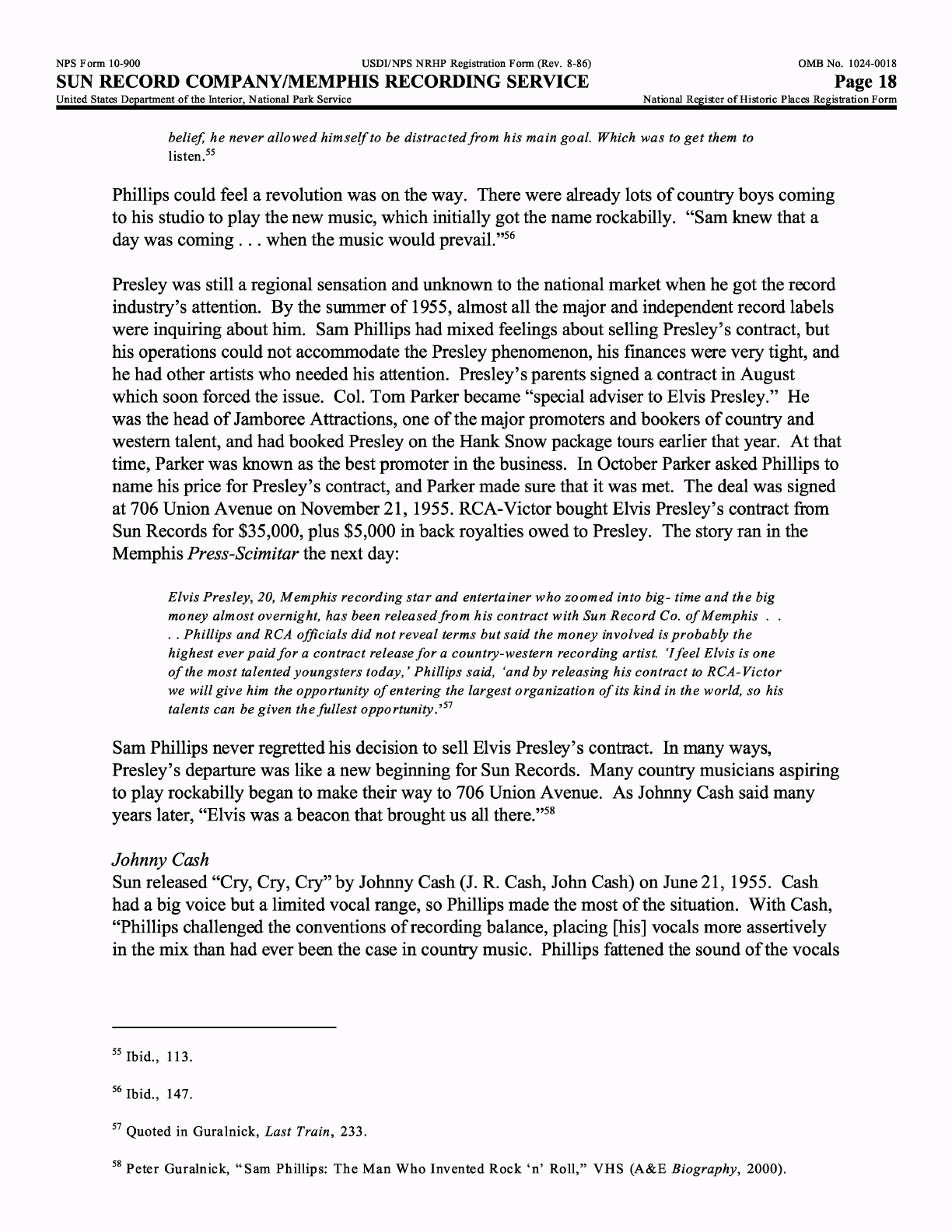
NFS
Form
10-900
USDI/NPS
NRHP
Registration
Form
(Rev. 8-86)
OMB
No.
1024-0018
SUN
RECORD COMPANY/MEMPHIS
RECORDING
SERVICE
Page
18
United
States
Department
of
the
Interior,
National
Park
Service
National
Register
of
Historic
Places
Registration
Form
belief,
he
never
allowed
himself
to
be
distracted
from
his
main
goal.
Which
was
to
get
them
to
listen.
55
Phillips
could
feel
a
revolution
was
on
the
way.
There
were
already
lots
of
country boys
coming
to
his
studio
to
play
the
new
music,
which
initially
got
the
name
rockabilly.
"Sam
knew
that
a
day
was
coming
.
..
when
the
music
would
prevail."
56
Presley
was
still
a
regional
sensation
and
unknown
to
the
national
market
when
he
got
the
record
industry's
attention.
By
the
summer
of
1955,
almost
all
the
major
and
independent
record
labels
were
inquiring
about
him.
Sam
Phillips
had
mixed
feelings
about
selling
Presley's
contract,
but
his
operations
could
not
accommodate
the
Presley
phenomenon,
his
finances
were
very
tight,
and
he
had
other
artists
who
needed
his attention.
Presley's
parents
signed
a
contract
in
August
which
soon
forced
the
issue.
Col.
Tom
Parker
became
"special
adviser
to
Elvis
Presley."
He
was
the
head
of
Jamboree Attractions,
one
of
the
major
promoters
and
bookers
of
country
and
western
talent,
and
had
booked
Presley
on
the
Hank
Snow
package
tours
earlier
that
year.
At
that
time,
Parker was
known
as
the
best
promoter
in
the
business.
In
October
Parker
asked
Phillips
to
name
his
price
for
Presley's
contract,
and
Parker
made
sure
that
it
was
met.
The
deal
was
signed
at
706
Union
Avenue
on
November
21,
1955.
RC
A-Victor
bought
Elvis
Presley's
contract
from
Sun
Records
for
$35,000,
plus
$5,000
in
back
royalties
owed
to
Presley.
The
story
ran
in
the
Memphis
Press-Scimitar
the
next
day:
Elvis
Presley,
20,
Memphis
recording
star
and
entertainer
who
zoomed
into
big-
time
and
the
big
money
almost
overnight,
has
been
released
from
his
contract
with
Sun
Record
Co.
of
Memphis
. .
. .
Phillips
and
RCA
officials
did
not
reveal
terms
but
said
the
money
involved
is
probably
the
highest
ever
paid
for
a
contract
release
for
a
country-western
recording
artist.
'Ifeel
Elvis
is
one
of
the
most
talented
youngsters
today,'
Phillips
said,
'and
by
releasing
his
contract
to
RCA-Victor
we
will
give
him
the
opportunity
of
entering
the
largest
organization
of
its
kind
in
the
world,
so
his
talents
can
be
given
the
fullest
opportunity.'
51
Sam
Phillips
never regretted
his decision
to
sell
Elvis
Presley's
contract.
In
many
ways,
Presley's
departure
was
like
a
new
beginning
for
Sun
Records.
Many
country
musicians
aspiring
to
play
rockabilly
began
to
make
their
way
to
706
Union
Avenue.
As
Johnny
Cash
said
many
years
later,
"Elvis
was
a
beacon
that
brought
us
all
there."
58
Johnny
Cash
Sun
released
"Cry,
Cry,
Cry"
by
Johnny
Cash
(J.
R.
Cash,
John
Cash)
on
June
21,
1955.
Cash
had
a
big
voice
but
a
limited
vocal
range,
so
Phillips
made
the
most
of
the
situation.
With
Cash,
"Phillips
challenged
the
conventions
of
recording
balance,
placing
[his]
vocals
more
assertively
in
the
mix
than
had
ever
been
the
case
in
country
music.
Phillips
fattened
the
sound
of
the
vocals
55
Ibid.,
113.
56
Ibid.,
147.
57
Quoted
in
Guralnick,
Last
Train,
233.
Peter
Guralnick,
"Sam
Phillips:
The
Man
Who
Invented
Rock
'n'
Roll,"
VHS
(A&E
Biography,
2000).
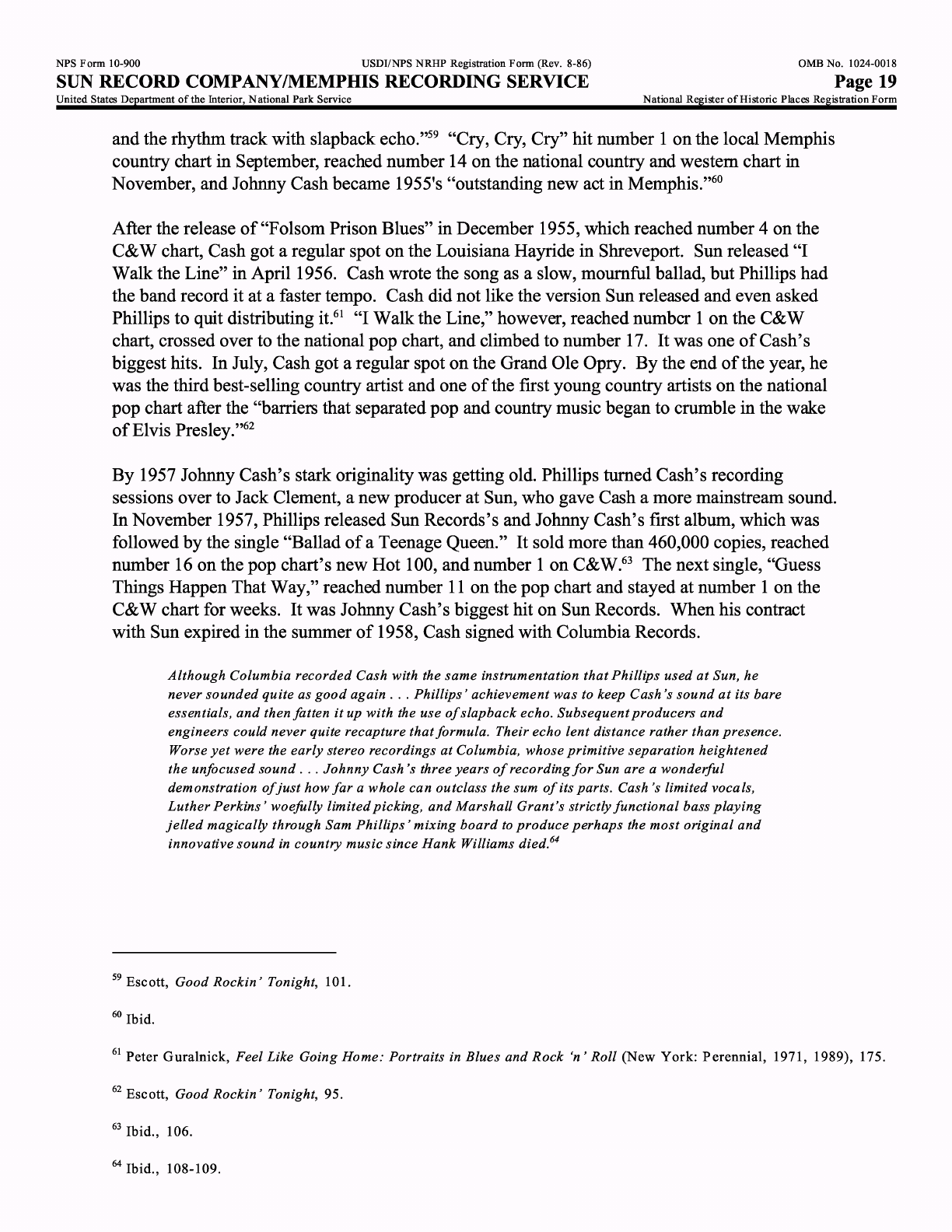
NFS
Form
10-900
USDI/NPS
NRHP
Registration
Form
(Rev. 8-86)
OMB
No.
1024-0018
SUN
RECORD COMPANY/MEMPHIS
RECORDING
SERVICE
Page
19
United
States
Department
of
the
Interior,
National
Park
Service
National
Register
of
Historic
Places
Registration
Form
and
the
rhythm
track
with
slapback
echo."
59
"Cry,
Cry,
Cry"
hit
number
1
on
the
local
Memphis
country
chart in
September,
reached
number
14
on
the
national
country
and
western
chart
in
November,
and
Johnny
Cash
became
1955's
"outstanding new
act
in
Memphis."
60
After
the
release
of
"Folsom
Prison
Blues"
in
December
1955,
which
reached
number
4
on
the
C&W
chart,
Cash
got
a
regular
spot
on
the
Louisiana
Hayride
in Shreveport. Sun
released
"I
Walk
the
Line"
in
April
1956.
Cash
wrote
the
song
as
a
slow,
mournful
ballad,
but
Phillips
had
the
band
record
it
at
a
faster
tempo.
Cash
did
not
like
the
version
Sun
released
and
even
asked
Phillips
to
quit
distributing
it.
61
"I
Walk
the
Line,"
however,
reached
number
1
on
the
C&W
chart,
crossed over
to
the
national
pop
chart,
and
climbed
to
number
17.
It
was
one
of
Cash's
biggest
hits.
In
July,
Cash
got
a
regular
spot
on
the
Grand
Ole
Opry.
By
the
end
of
the
year,
he
was
the
third
best-selling
country
artist
and
one
of
the
first
young
country
artists
on
the
national
pop chart after
the
"barriers
that
separated
pop
and
country
music
began
to
crumble
in
the
wake
ofElvisPresley."
62
By
1957
Johnny
Cash's
stark
originality
was
getting
old.
Phillips
turned
Cash's
recording
sessions
over
to
Jack
Clement,
a
new
producer
at
Sun,
who
gave
Cash
a
more
mainstream
sound.
In
November
1957,
Phillips
released
Sun
Records's
and
Johnny
Cash's
first
album,
which
was
followed
by
the
single
"Ballad
of
a
Teenage
Queen." It
sold
more
than
460,000
copies,
reached
number
16
on
the
pop
chart's
new Hot
100,
and
number
1
on
C&W.
63
The
next
single,
"Guess
Things
Happen
That
Way,"
reached
number
11
on
the
pop chart
and stayed
at
number
1
on
the
C&W
chart
for weeks.
It
was
Johnny
Cash's
biggest
hit
on
Sun
Records.
When
his
contract
with
Sun
expired
in
the
summer
of
1958,
Cash
signed
with
Columbia
Records.
Although
Columbia
recorded
Cash
-with
the
same
instrumentation
that Phillips
used
at
Sun,
he
never
sounded
quite
as
good
again
. . .
Phillips'
achievement
was
to
keep
Cash's
sound
at
its
bare
essentials,
and
then
fatten
it
up
with
the
use
of
slapback
echo.
Subsequent
producers
and
engineers
could
never
quite
recapture that
formula.
Their
echo
lent
distance
rather
than
presence.
Worse
yet
were
the
early
stereo
recordings
at
Columbia,
whose
primitive
separation
heightened
the
unfocused
sound
. . .
Johnny
Cash
's
three
years
of
recording
for
Sun
are
a
wonderful
demonstration
of
just
how
far
a
whole
can
outclass
the
sum
of
its
parts.
Cash
's
limited
vocals,
Luther
Perkins'
woefully
limited picking,
and
Marshall
Grant's
strictly
functional
bass
playing
jelled
magically
through
Sam
Phillips'
mixing
board
to
produce
perhaps
the
most
original
and
innovative
sound
in
country
music
since
Hank
Williams
died.
64
59
60
Escott,
Good
Rockin'
Tonight,
101.
Ibid.
61
Peter
Guralnick,
Feel
Like
Going
Home:
Portraits
in
Blues
and
Rock
'n'
Roll
(New
York:
Perennial,
1971,
1989),
175.
62
Escott,
Good
Rockin'
Tonight,
95.
63
Ibid.,
106.
Ibid.,
108-109.
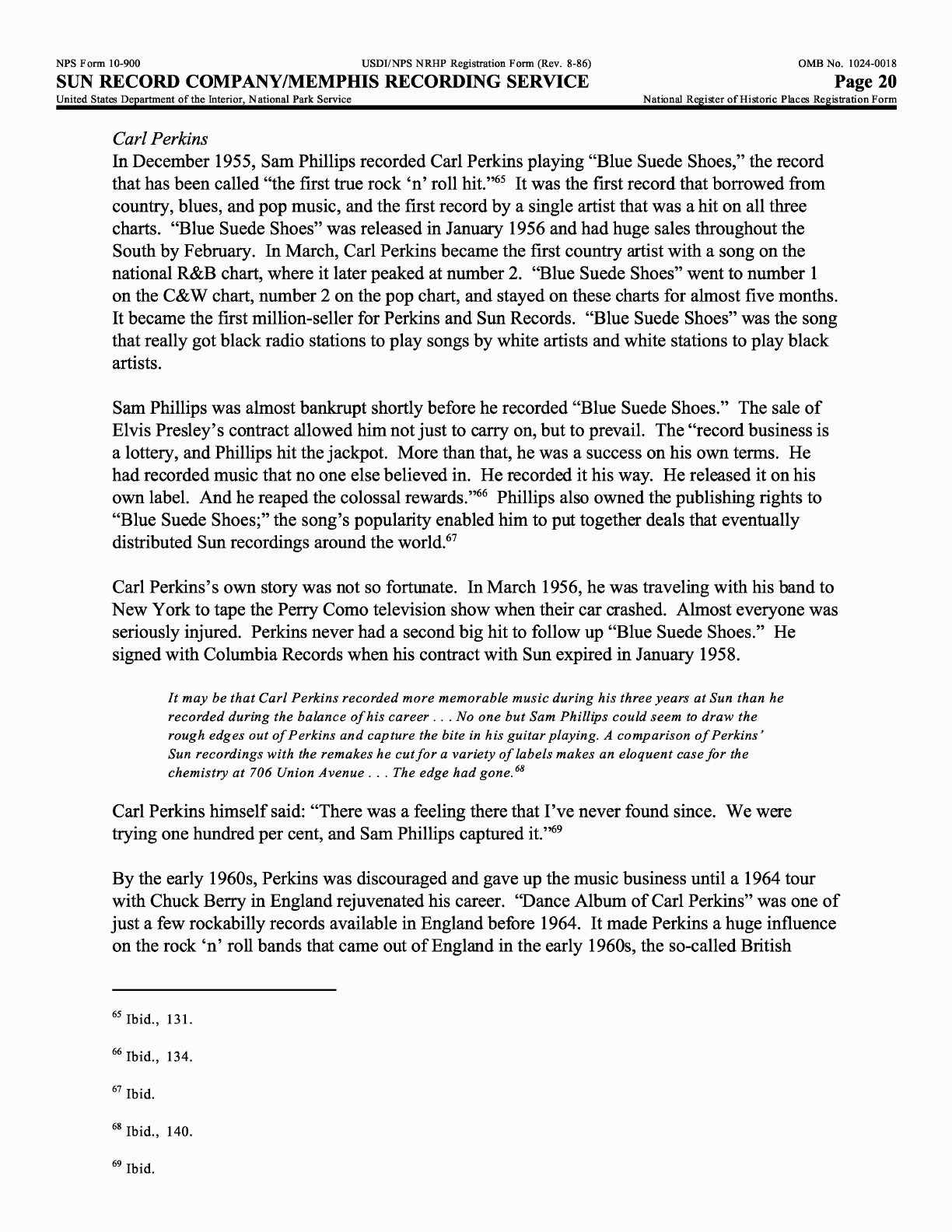
NFS
Form
10-900
USDI/NPS
NRHP
Registration
Form
(Rev. 8-86)
OMB
No.
1024-0018
SUN
RECORD COMPANY/MEMPHIS
RECORDING
SERVICE
Page
20
United
States
Department
of
the
Interior,
National
Park
Service
National
Register
of
Historic
Places
Registration
Form
Carl
Perkins
In
December
1955,
Sam
Phillips
recorded
Carl
Perkins
playing
"Blue
Suede
Shoes,"
the
record
that
has
been
called
"the
first
true
rock
'n'
roll
hit."
65
It
was
the
first
record
that
borrowed
from
country,
blues,
and
pop
music,
and
the
first
record by
a
single
artist
that
was
a
hit
on
all
three
charts.
"Blue
Suede
Shoes"
was
released
in January
1956
and
had
huge
sales
throughout
the
South
by
February.
In
March,
Carl
Perkins
became
the
first
country
artist
with
a
song
on
the
national
R&B
chart,
where
it
later
peaked
at
number
2.
"Blue
Suede
Shoes"
went
to
number
1
on
the
C&W
chart,
number
2
on
the
pop
chart,
and stayed
on
these
charts
for
almost
five
months.
It
became
the
first
million-seller
for
Perkins
and
Sun
Records.
"Blue
Suede
Shoes"
was
the
song
that
really
got
black
radio
stations
to
play
songs
by
white
artists
and
white
stations
to
play
black
artists.
Sam
Phillips
was
almost
bankrupt
shortly
before
he
recorded
"Blue
Suede
Shoes."
The
sale
of
Elvis
Presley's
contract
allowed
him
not
just
to
carry
on,
but
to
prevail.
The
"record
business
is
a
lottery,
and
Phillips
hit
the
jackpot.
More
than
that,
he
was
a
success
on
his
own
terms.
He
had
recorded
music
that
no
one
else
believed
in.
He
recorded
it
his
way.
He
released it
on
his
own
label.
And
he
reaped
the
colossal
rewards."
66
Phillips
also
owned
the
publishing
rights
to
"Blue
Suede
Shoes;"
the
song's
popularity
enabled
him
to
put
together
deals
that
eventually
distributed
Sun
recordings
around
the
world.
67
Carl
Perkins's
own
story
was
not
so
fortunate. In
March
1956,
he
was
traveling
with
his
band
to
New
York
to
tape the
Perry
Como
television
show
when
their
car
crashed.
Almost
everyone
was
seriously
injured.
Perkins
never
had
a
second
big
hit
to
follow
up
"Blue
Suede
Shoes."
He
signed
with
Columbia
Records
when
his
contract
with
Sun
expired
in
January
1958.
It
may
be
that
Carl
Perkins
recorded
more
memorable
music
during
his three
years
at
Sun
than
he
recorded
during
the
balance
of
his
career
. . .
No
one
but
Sam
Phillips
could
seem
to
draw
the
rough
edges
out
of
Perkins
and
capture
the
bite
in
his
guitar
playing.
A
comparison
of
Perkins'
Sun
recordings
-with
the
remakes
he
cut
for
a
variety
of
labels
makes
an
eloquent
case
for
the
chemistry
at
706
Union
Avenue
. . .
The
edge
had
gone.
68
Carl
Perkins
himself
said:
"There
was
a
feeling there
that
I've
never
found
since.
We were
trying
one
hundred
per
cent,
and
Sam
Phillips
captured
it."
69
By
the early
1960s,
Perkins
was
discouraged
and
gave
up
the
music
business
until
a
1964
tour
with
Chuck Berry
in
England rejuvenated
his
career.
"Dance
Album
of
Carl
Perkins"
was
one
of
just
a
few
rockabilly
records
available
in
England
before
1964.
It
made
Perkins
a
huge influence
on
the
rock
'n'
roll
bands
that
came
out
of
England
in
the
early
1960s,
the
so-called
British
65
Ibid.,
131.
66
Ibid.,
134.
67
Ibid.
68
Ibid.,
140.
69
Ibid.
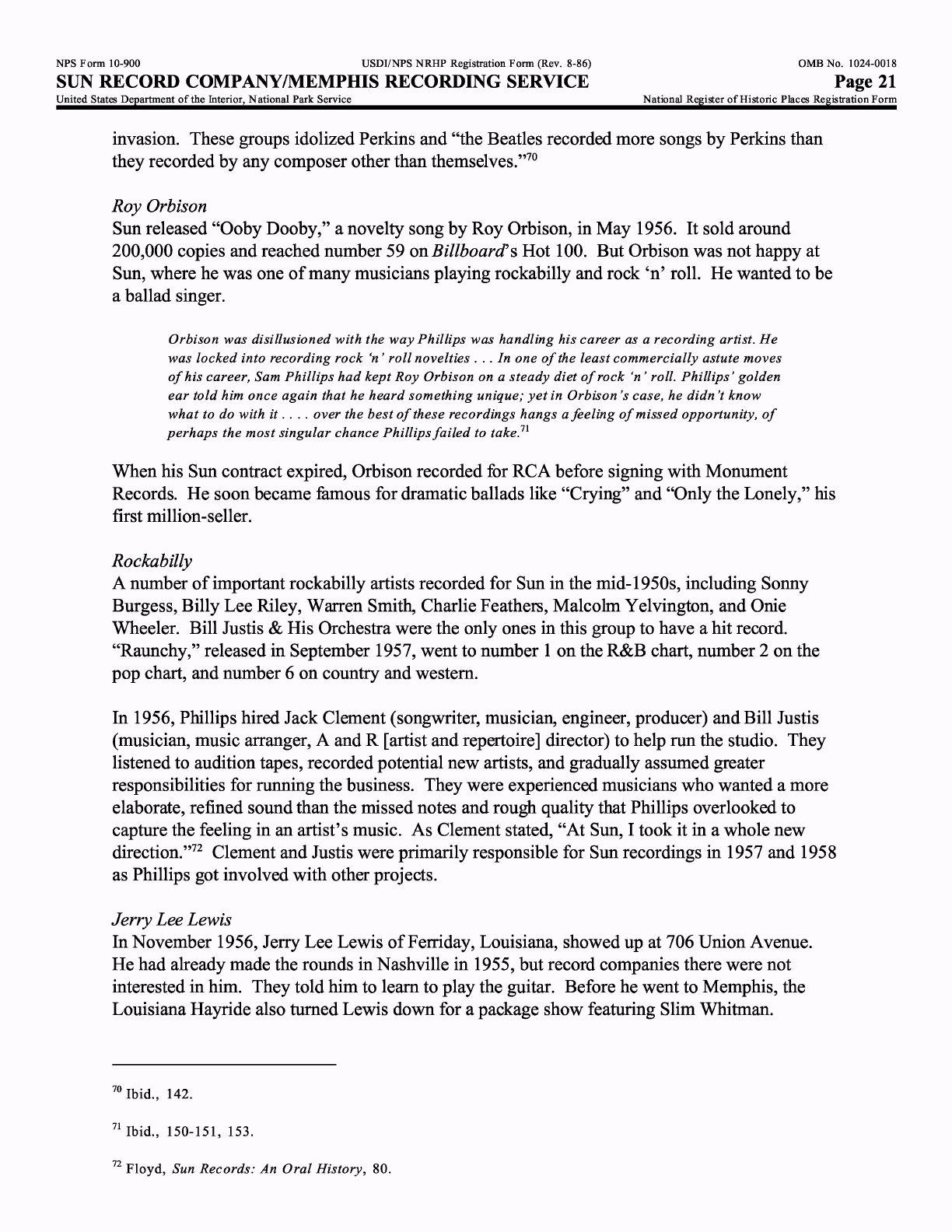
NFS
Form
10-900
USDI/NPS
NRHP
Registration
Form
(Rev. 8-86)
OMB
No.
1024-0018
SUN
RECORD COMPANY/MEMPHIS
RECORDING
SERVICE
Page
21
United
States
Department
of
the
Interior,
National
Park
Service
National
Register
of
Historic
Places
Registration
Form
invasion.
These
groups
idolized
Perkins
and
"the
Beatles
recorded
more
songs
by
Perkins
than
they
recorded
by
any
composer
other
than
themselves."
70
Roy
Orbison
Sun
released
"Ooby
Dooby,"
a
novelty
song
by
Roy
Orbison,
in
May
1956.
It
sold
around
200,000
copies
and
reached
number
59
on
Billboard"s
Hot
100.
But
Orbison
was
not
happy
at
Sun,
where
he
was
one
of
many
musicians
playing
rockabilly
and rock
'n'
roll.
He
wanted
to
be
a
ballad
singer.
Orbison
was
disillusioned
with
the
way
Phillips
was
handling
his
career
as
a
recording
artist.
He
was
locked
into
recording
rock
'n'
roll
novelties
. . .
In
one
of
the
least
commercially
astute moves
of
his
career,
Sam
Phillips
had
kept
Roy
Orbison
on
a
steady
diet
of
rock
'n
'
roll.
Phillips'
golden
ear
told
him
once again
that
he
heard
something
unique;
yet
in
Orbison's
case,
he
didn
't
know
what
to
do
with
it.
. . .
over
the
best
of
these
recordings
hangs
a
feeling
of
missed
opportunity,
of
perhaps
the
most
singular
chance
Phillips
failed
to
take.
11
When
his
Sun
contract
expired,
Orbison
recorded
for
RCA
before
signing
with
Monument
Records.
He
soon
became
famous
for
dramatic
ballads
like
"Crying"
and
"Only
the
Lonely,"
his
first
million-seller.
Rockabilly
A
number
of
important
rockabilly
artists
recorded
for
Sun
in
the
mid-1950s,
including
Sonny
Burgess,
Billy
Lee
Riley,
Warren
Smith,
Charlie
Feathers,
Malcolm
Yelvington,
and
Onie
Wheeler.
Bill
Justis
&
His
Orchestra
were
the
only
ones
in
this
group
to
have
a
hit
record.
"Raunchy,"
released
in
September
1957,
went
to
number
1
on
the
R&B
chart,
number
2
on
the
pop
chart,
and
number
6
on
country
and
western.
In
1956,
Phillips
hired
Jack
Clement
(songwriter,
musician,
engineer,
producer)
and
Bill
Justis
(musician,
music
arranger,
A
and
R
[artist
and
repertoire]
director)
to
help
run
the
studio.
They
listened
to
audition
tapes,
recorded
potential new
artists,
and
gradually assumed
greater
responsibilities
for
running
the
business.
They
were experienced
musicians
who
wanted
a
more
elaborate,
refined
sound
than
the
missed
notes
and
rough
quality
that
Phillips
overlooked
to
capture
the
feeling in
an
artist's
music.
As
Clement
stated,
"At
Sun,
I
took
it
in
a
whole
new
direction."
72
Clement
and
Justis
were
primarily
responsible
for
Sun
recordings
in
1957
and
1958
as
Phillips
got
involved
with
other
projects.
Jerry
Lee
Lewis
In
November
1956,
Jerry
Lee
Lewis
of
Ferriday,
Louisiana,
showed
up
at
706
Union
Avenue.
He
had
already
made
the
rounds
in
Nashville
in
1955,
but
record
companies
there
were
not
interested
in
him.
They
told him
to
learn
to
play
the
guitar.
Before
he
went
to
Memphis,
the
Louisiana
Hayride
also
turned
Lewis
down
for
a
package
show
featuring
Slim
Whitman.
Ibid.,
142.
71
Ibid.,
150-151,
153.
72
Floyd,
Sun
Records:
An
Oral
History,
80.

NFS
Form
10-900
USDI/NPS
NRHP
Registration
Form
(Rev. 8-86)
OMB
No.
1024-0018
SUN
RECORD COMPANY/MEMPHIS
RECORDING
SERVICE
Page
22
United
States
Department
of
the
Interior,
National
Park
Service
National
Register
of
Historic
Places
Registration
Form
Sam
Phillips
was
out
of
town
and
Jack Clement
was
in
charge
of
Jerry
Lee
Lewis's
audition.
Lewis
played
a
variety
of
songs
for
Clement,
who
told him
to
go
home
and
learn
some
rock
'n'
roll.
Phillips
was
ready
to
sign
Lewis
as
soon
as
he
heard
the
tape,
partly
because
he
"had
been
wanting
to
get
off
this
guitar
scene
and
show
it
could
be
done
with
other
instruments."
73
Lewis
did
not
have
a
band,
so
Clement
set
him
up
with
some
local
musicians.
"In
the
combination
of
Jerry
Lee
Lewis,
Roland
Janes
[guitar],
and
J.M.
Van
Eaton
[drums],
a
magic
formula
had
fallen
into
Sam
Phillips'
lap."
74
"Crazy
Arms"
was
Lewis's
first
release
in
December
1956.
It
sold
well
in
the
region
but
did
not
make
the
national
charts.
"Whole
Lot
of
Shakin'
Going
On"
was
recorded
in
February
1957.
It
made
the
national
C&W
chart
in
June
and
entered
the
pop
chart's
Hot
100
at
number
70
by
the
end
of
the
month.
Lewis's
first
tour
was
with
Johnny
Cash
and
Carl
Perkins
in
April
and
May
1957.
Initially
he
was
shy
on
stage.
Cash
and
Perkins
encouraged
him
to
put
on
more
of
a
show,
and
immediately
there
was
a
radical
change.
On
Sunday,
July
28,
1957,
Jerry
Lee
Lewis's
appearance
on
the
Steve
Alien
Show
made
television
and
music
history.
Like
Elvis
's
television
appearances,
Jerry's
spots
on
the
Alien
show
are
landmarks
in
the
history
of
rock
'n'
roll.
He
pounded
the
piano,
eyes
fixed
above
with
messianic
intensity.
When
it
came
time
to
sing,
he
glared
at
the
camera
with
a
wild-eyed
fury
. . .
At
the
top
of
the
last
chorus,
he
kicked
the
piano
stool
back
across
the
stage
. . .
Set
in
the
context
of
the
jugglers,
ventriloquists,
and
singing-sister
acts
that
were
the
staples
of
television
variety
in
those
days,
Jerry's
performance
was
nothing
short
of
demonic.
75
After
the
Alien
show,"Whole
Lot
of
Shakin'"
hit
number
1
on
the
C&W
and
R&B charts,
and
number
3
on
the
pop
chart.
"Great
Balls
of
Fire," released
in
November
1957
as
the
followup
to
"Whole
Lot
of
Shakin',"
reached
number
1
on
the
country
and
western
chart,
number
2
on
the
pop
chart,
and number
3
on
R&B.
"Breathless"
and
"High
School
Confidential," released
in
1958,
also
made
all
three
national
Billboard
charts.
"With
Presley
halfway
into
the
Army,
Lewis
was
just
about
the
hottest
phenomenon
in
pop
music."
76
Lewis
was
extraordinarily
prolific
in
the
studio
during
1957
and
early
1958.
With
Roland
Janes
and
J.
M.
Van
Eaton
trying
to
follow
him
as
best
they
could,
Lewis
would
plunder
his
subconscious
for
songs,
hoping
to
find
something
that
would
catch
Phillips's
ear.
The
variety
was
enormous:
sentimental
hillbilly
weepers
in
waltz
time,
such
as
"I'm
Throwing
Rice;"
contemporary
country
hits like
"Singing
the
Blues;
"
R&B
songs
like
"Sixty
Minute
Man
"
and
"Honey
Hush;"
old
pop
favorites
such
as
"Love
Letters
in
the
Sand;"
folk
songs
like
"Crawdad
Hole;"
a
little
gospel
in
the
form
of
"Old
Time
Religion;"
and
even
one
giantly
egotistical
original,
"Lewis
Boogie."
Surprisingly,
it
is
the
music
left
in
the
outtake
boxes
that
provides
the
definitive
proof
of
Lewis's
genius.
In
his
hands,
an
impossibly
wide
variety
of
material
is
recast
into
a
uniform
body
of
work.
.
.
If
Sam
Phillips thought
a
song
had
merit
and
wanted
to
hear
it
another
way,
Lewis
could
73
Escott,
Good
Rockin'
Tonight,
192.
Ibid.,
193.
75
Ibid.,
196-197.
Ibid.,
198.
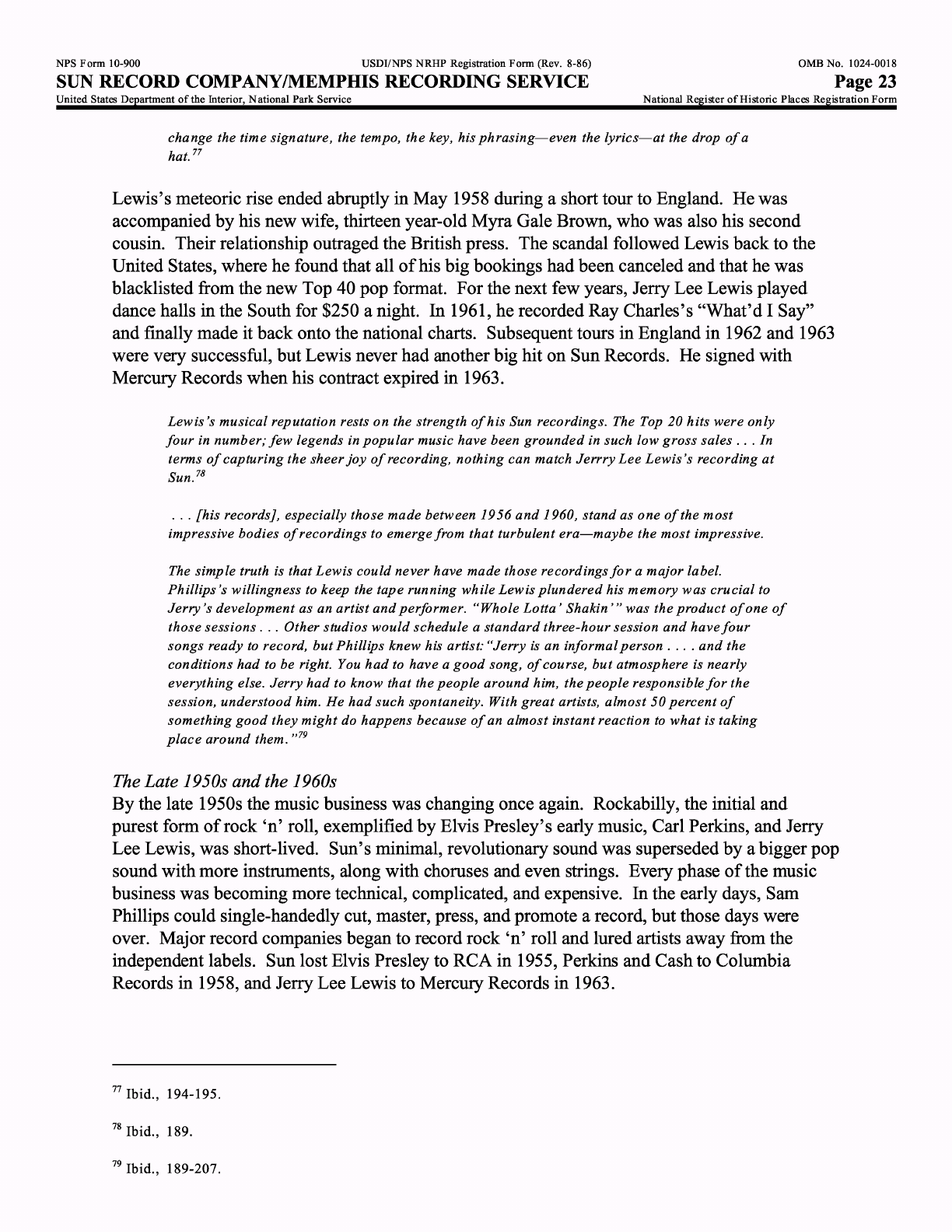
NFS
Form
10-900
USDI/NPS
NRHP
Registration
Form
(Rev. 8-86)
OMB
No.
1024-0018
SUN
RECORD COMPANY/MEMPHIS
RECORDING
SERVICE
Page
23
United
States
Department
of
the
Interior,
National
Park
Service
National
Register
of
Historic
Places
Registration
Form
change
the
time
signature,
the
tempo,
the
key,
his
phrasing—even
the
lyrics—at
the
drop
of
a
hat.
77
Lewis's
meteoric
rise ended
abruptly
in
May
1958
during
a
short
tour
to
England.
He
was
accompanied
by
his
new
wife,
thirteen
year-old
Myra
Gale
Brown, who was
also
his
second
cousin.
Their
relationship
outraged
the
British
press.
The
scandal
followed
Lewis
back
to
the
United
States,
where
he
found
that
all
of
his
big
bookings
had
been
canceled
and
that
he
was
blacklisted
from
the
new
Top
40
pop
format.
For
the
next
few
years,
Jerry
Lee
Lewis
played
dance
halls
in
the
South for
$250
a
night.
In
1961,
he
recorded
Ray
Charles's
"What'd
I
Say"
and
finally
made
it
back
onto
the
national
charts.
Subsequent
tours
in
England
in
1962
and
1963
were
very
successful,
but
Lewis
never
had
another
big
hit
on
Sun Records.
He
signed
with
Mercury
Records
when
his
contract
expired
in
1963.
Lewis's
musical
reputation
rests
on
the
strength
of
his
Sun
recordings.
The
Top
20
hits
were
only
four
in
number;
few
legends
in
popular
music
have
been
grounded
in
such
low
gross
sales
. . .
In
terms
of
capturing
the
sheer
joy
of
recording,
nothing
can
match
Jerrry
Lee
Lewis's
recording
at
Sun.
78
. . .
[his
records],
especially
those made
between
1956
and
1960,
stand
as
one
of
the
most
impressive
bodies
of
recordings
to
emerge
from
that
turbulent
era—maybe
the
most
impressive.
The
simple
truth
is
that
Lewis
could never
have
made
those
recordings
for
a
major
label.
Phillips's
willingness
to
keep
the
tape
running
while
Lewis
plundered
his
memory
was
crucial
to
Jerry's
development
as
an
artist
and
performer.
"Whole
Lotta'
Shakin'"
was
the
product
of
one
of
those
sessions
. . .
Other
studios
would
schedule
a
standard
three-hour
session
and
have
four
songs
ready
to
record,
but
Phillips
knew
his
artist:
"Jerry
is
an
informal
person
....
and
the
conditions
had
to
be
right.
You
had
to
have
a
good
song,
of
course,
but
atmosphere
is
nearly
everything
else.
Jerry
had
to
know
that
the
people
around
him,
the
people
responsible
for
the
session,
understood
him.
He
had
such spontaneity.
With
great
artists,
almost
50
percent
of
something
good
they
might
do
happens
because
of
an
almost
instant
reaction
to
what
is
taking
place
around
them.
"
79
The
Late
1950s
and
the
1960s
By
the
late
1950s
the
music
business
was
changing
once
again.
Rockabilly,
the
initial
and
purest
form
of
rock
'n'
roll,
exemplified
by
Elvis
Presley's
early
music,
Carl
Perkins,
and
Jerry
Lee Lewis,
was
short-lived.
Sun's
minimal,
revolutionary
sound
was
superseded
by
a
bigger
pop
sound
with
more
instruments,
along
with
choruses
and
even
strings.
Every
phase
of
the
music
business
was
becoming
more
technical,
complicated, and
expensive.
In
the
early
days,
Sam
Phillips
could single-handedly
cut,
master, press,
and
promote
a
record,
but
those
days were
over.
Major
record
companies
began
to
record
rock
'n'
roll
and
lured
artists
away
from
the
independent
labels.
Sun
lost
Elvis
Presley
to
RCA
in
1955,
Perkins
and
Cash
to
Columbia
Records
in
1958,
and
Jerry
Lee
Lewis
to
Mercury
Records
in
1963.
Ibid.,
194-195.
78
Ibid.,
189.
Ibid.,
189-207.

NFS
Form
10-900
USDI/NPS
NRHP
Registration
Form
(Rev. 8-86)
OMB
No.
1024-0018
SUN
RECORD COMPANY/MEMPHIS
RECORDING
SERVICE
Page
24
United
States
Department
of
the
Interior,
National
Park
Service_____________________________________National
Register
of
Historic
Places
Registration
Form
Sun
Records
had
outgrown
706
Union
Avenue
by
the
late
1950s
also.
The
studio
itself
was
not
big
enough
to
accommodate
larger
groups
of
musicians,
the
control
room
was
too
small
for
the
new
multitrack
recording
equipment,
and Phillips
needed
more
space
so
he
could
hire
more
employees.
In
the
summer
of
1958,
Phillips
bought
a
building
nearby
at
639
Madison Avenue
for his
new
headquarters.
They
occasionally
used
the
studio
at
the
new
building
beginning
in
January
1960,
but
it
was
not
officially
opened until
September
17.
Around
that
time,
Phillips
was
quoted
as
follows:
"Woodshed
recordings
have
had
it.
You've
got
to
have
latitude
today—all the
electronic
devices,
built-in
high
and
low
frequency
and
attenuation,
echoes,
channel splitting
and
metering
on
everything."
80
The
new
studio
on
Madison
Avenue,
one
of
the
most modern
in
the
United
States
at
that
time,
was
"everything
that
706
was
not,
spacious,
state-
of-the-art,
and
soulless."
81
Phillips
began
to
expand
his
business
interests
in
the
mid-1950s.
He
started
a
new
label
in
1957,
Phillips
International,
to
record
pop
and
jazz
as
well
as
rock
'n'
roll,
and
he
began
to
let
other
people
use
his
studio
for
custom
recording.
In
1961
he
opened
a
studio
in
Nashville
at
317
7
th
Avenue
North.
Phillips
started
his
first
radio
station
in
1955,
something
he
had
wanted
to do
for
a
long
time.
WHER,
with
"1,000
beautiful
watts,"
was
the
country's
first "all-girl"
station
at
a
time
when
women
did
not
yet
work
in
radio.
Phillips's
original
idea
for
his
first
station
was
a
24-hour
"all
Negro"
station,
but
the
FCC
turned
down
that
application.
Phillips
went
on
to
build
a
radio
empire,
including
a
number
of
stations
around
his
hometown
in Florence,
Alabama.
He
was
also
an
original
shareholder
in
Holiday
Inns,
Inc.
which
originated
in
Memphis
in
1952.
All
of
these
ventures
contributed
to
Phillips's
waning
involvement
in
his
record
business.
Phillips
hired
managers,
producers,
and engineers
to
run
his
studios
during
this
period,
and
they
recorded
all
kinds
of
musical
artists.
Two
songs
recorded
at
706
Union
Avenue
shortly
before
the
move
to
the
new
studio
on
Madison
Avenue
became
hits,
but
they
were released
on
the
Phillips
International
label.
"Lonely Weekends"
was Charlie
Rich's
first
hit.
He
eventually
became
a
big
star
in
the early
1970s
with
the
song
"Behind
Closed
Doors."
Carl
Mann's
unusual
version
of
"Mona
Lisa"
also
became
a
hit
in
1959,
reaching
number
24
on
Billboard's
R&B
chart
and
number
25
on
the
pop
chart.
In
1962,
Frank
Frost
made
"some
of
the last
truly
great
blues recordings
to
emerge
from
Memphis,"
82
but
the
classic
Sun
sound
had
faded
by
then.
The
last
time
Phillips
recorded
an
artist
as
president
of
Sun
Records
was
a
session
for
Dane
Stinit
in
November
1966.
83
The
last
record
on
the
Sun
label
was
released
in January
1968.
Phillips
had
received
a
number
of
offers
for
the
Sun
catalog
over
the
years.
In
July
1969,
he
sold
the entire
catalog,
approximately
7,000
master
recordings,
for
$1
million
to
Shelby
S.
Singleton,
Jr.,
a
former
Mercury
Records
executive
who
had
launched
his
own
company
in
1966.
Singleton
reorganized
the
company
as
the
Sun
International
Corporation,
which
is
now
the
Sun
80
Ibid.,
224
81
Ibid.,
222.
82
Ibid.,
230
Ibid.
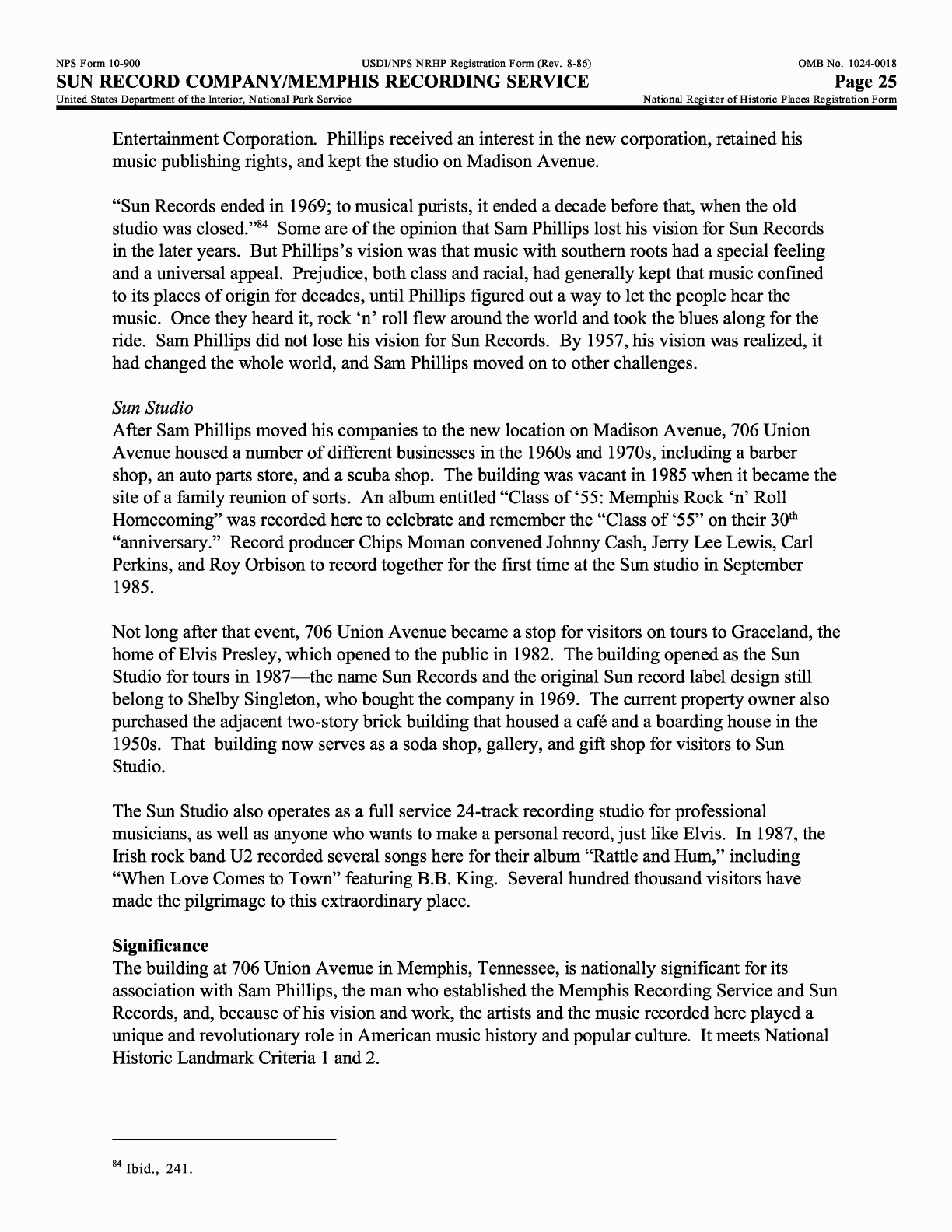
NFS
Form
10-900
USDI/NPS
NRHP
Registration
Form
(Rev. 8-86)
OMB
No.
1024-0018
SUN
RECORD COMPANY/MEMPHIS
RECORDING
SERVICE
Page
25
United
States
Department
of
the
Interior,
National
Park
Service
National
Register
of
Historic
Places
Registration
Form
Entertainment
Corporation.
Phillips received
an
interest
in
the new
corporation,
retained
his
music
publishing
rights,
and
kept
the
studio
on
Madison
Avenue.
"Sun
Records
ended
in
1969;
to
musical
purists,
it
ended
a
decade
before
that,
when
the
old
studio
was
closed."
84
Some
are
of
the
opinion
that
Sam
Phillips lost
his
vision
for
Sun
Records
in
the
later
years.
But
Phillips's
vision
was
that
music
with
southern
roots
had
a
special
feeling
and
a
universal
appeal.
Prejudice,
both
class
and
racial,
had
generally
kept
that
music
confined
to
its
places
of
origin
for
decades,
until
Phillips
figured
out
a
way
to
let
the
people
hear
the
music.
Once
they
heard
it,
rock
'n'
roll
flew
around
the
world
and
took
the
blues
along
for
the
ride.
Sam
Phillips
did
not
lose
his
vision
for
Sun
Records.
By
1957,
his
vision
was
realized,
it
had
changed
the
whole world,
and
Sam
Phillips
moved
on
to
other
challenges.
Sun
Studio
After
Sam
Phillips
moved
his
companies
to
the
new
location
on
Madison
Avenue,
706
Union
Avenue
housed
a
number
of
different
businesses
in
the
1960s
and
1970s,
including
a
barber
shop,
an
auto
parts
store,
and
a
scuba
shop.
The
building
was
vacant in
1985
when
it
became
the
site
of
a
family
reunion
of
sorts.
An
album
entitled
"Class
of'55:
Memphis
Rock
'n'
Roll
Homecoming"
was
recorded
here
to
celebrate
and
remember
the
"Class
of
'55"
on
their
30
th
"anniversary."
Record
producer
Chips
Moman convened
Johnny
Cash,
Jerry
Lee Lewis,
Carl
Perkins,
and
Roy
Orbison
to
record
together
for
the
first time
at
the
Sun
studio
in
September
1985.
Not
long
after
that
event,
706
Union
Avenue
became
a
stop
for
visitors
on
tours
to
Graceland,
the
home
of
Elvis
Presley,
which
opened
to
the
public
in
1982.
The
building
opened
as
the
Sun
Studio
for tours
in
1987—the
name
Sun
Records
and
the
original
Sun
record
label
design
still
belong
to
Shelby
Singleton,
who
bought
the
company
in
1969.
The
current
property
owner
also
purchased
the
adjacent
two-story
brick
building
that
housed
a cafe
and
a
boarding
house
in
the
1950s.
That
building
now
serves
as
a
soda
shop,
gallery,
and
gift
shop
for
visitors
to Sun
Studio.
The Sun
Studio
also
operates
as
a
full
service
24-track
recording
studio
for
professional
musicians,
as
well
as
anyone
who
wants
to
make
a
personal
record,
just
like Elvis.
In
1987,
the
Irish
rock
band
U2
recorded
several
songs
here
for
their
album
"Rattle
and
Hum,"
including
"When
Love
Comes
to
Town"
featuring
B.B.
King.
Several
hundred
thousand
visitors have
made
the
pilgrimage
to
this
extraordinary
place.
Significance
The
building
at
706
Union
Avenue
in
Memphis,
Tennessee,
is
nationally
significant for
its
association
with
Sam
Phillips,
the
man
who
established
the
Memphis
Recording
Service
and
Sun
Records,
and,
because
of
his
vision
and
work, the
artists
and
the
music
recorded
here
played
a
unique
and
revolutionary
role
in
American
music
history
and
popular
culture.
It
meets
National
Historic
Landmark
Criteria
1
and
2.
Ibid.,
241.
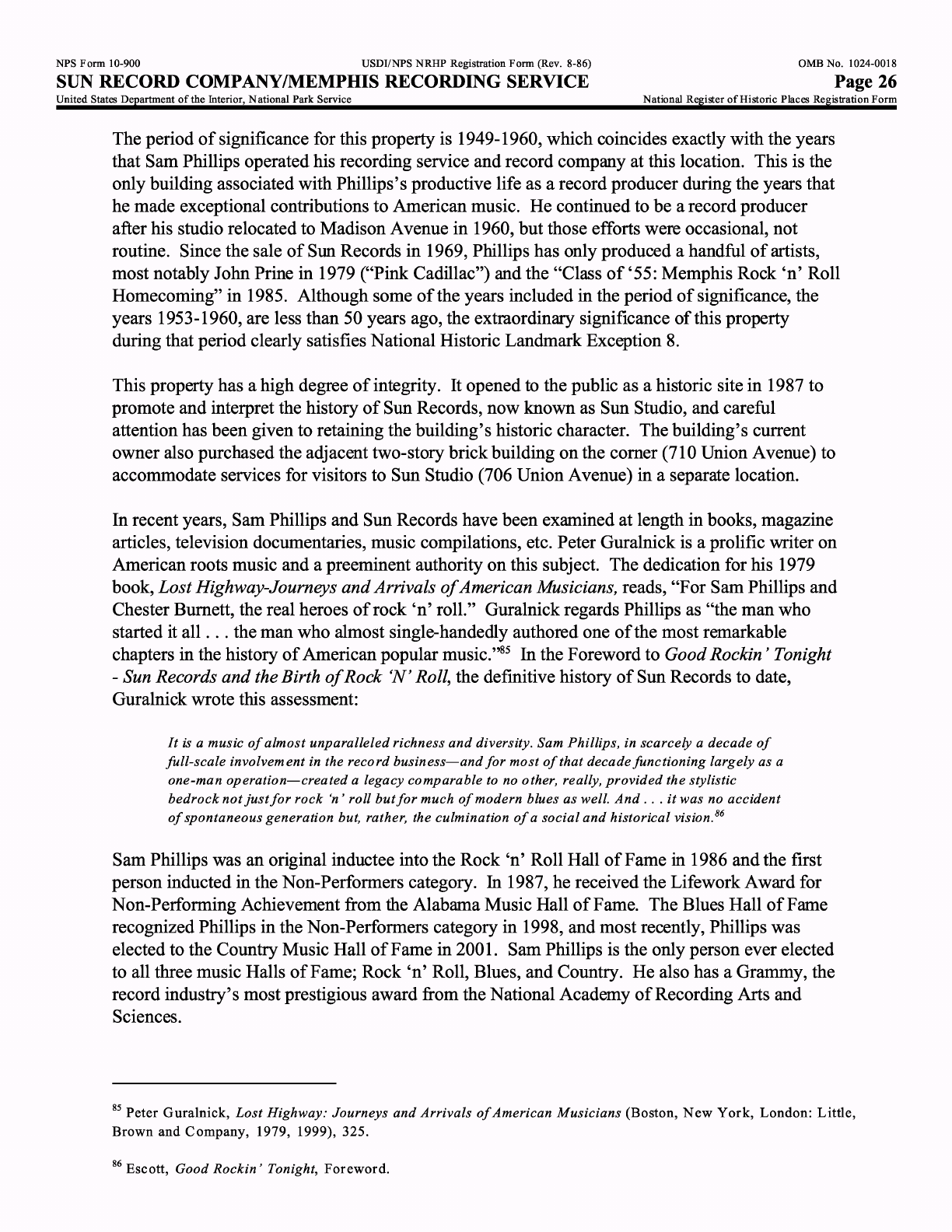
NFS
Form
10-900
USDI/NPS
NRHP
Registration
Form
(Rev. 8-86)
OMB
No.
1024-0018
SUN
RECORD COMPANY/MEMPHIS
RECORDING
SERVICE
Page
26
United
States
Department
of
the
Interior,
National
Park
Service
National
Register
of
Historic
Places
Registration
Form
The
period
of
significance
for
this
property
is
1949-1960,
which
coincides
exactly
with
the
years
that
Sam
Phillips
operated
his
recording
service
and
record
company
at
this location.
This
is
the
only
building
associated with
Phillips's
productive
life
as
a
record producer
during the
years
that
he
made
exceptional
contributions
to
American
music. He
continued
to
be
a
record
producer
after
his
studio
relocated
to
Madison
Avenue
in
1960,
but
those
efforts
were
occasional,
not
routine.
Since
the
sale
of
Sun
Records in
1969,
Phillips
has
only
produced
a
handful
of
artists,
most
notably
John
Prine
in
1979
("Pink
Cadillac")
and
the
"Class
of
'55:
Memphis
Rock
'n'
Roll
Homecoming"
in
1985.
Although
some
of
the
years
included
in
the
period
of
significance,
the
years
1953-1960,
are
less
than
50
years
ago,
the
extraordinary
significance
of
this
property
during
that
period
clearly
satisfies
National
Historic
Landmark
Exception
8.
This
property
has
a
high
degree
of
integrity.
It
opened
to
the
public
as
a
historic
site
in
1987
to
promote
and
interpret
the
history
of
Sun
Records,
now
known
as
Sun Studio,
and
careful
attention
has
been
given
to
retaining
the
building's
historic
character.
The
building's
current
owner
also
purchased
the
adjacent
two-story
brick
building
on
the
corner
(710
Union
Avenue)
to
accommodate
services
for
visitors
to Sun
Studio
(706
Union
Avenue)
in
a
separate
location.
In
recent
years,
Sam
Phillips and
Sun
Records
have
been
examined
at
length
in
books,
magazine
articles,
television
documentaries, music compilations,
etc.
Peter
Guralnick
is
a
prolific
writer
on
American
roots
music
and
a
preeminent
authority
on
this
subject.
The
dedication
for his
1979
book,
Lost
Highway-Journeys
and
Arrivals
of
American
Musicians,
reads,
"For
Sam
Phillips and
Chester
Burnett,
the
real
heroes
of
rock
'n'
roll."
Guralnick
regards
Phillips
as
"the
man
who
started
it
all...
the
man
who almost
single-handedly
authored
one
of
the
most
remarkable
chapters
in
the
history
of
American
popular
music."
85
In
the
Foreword
to
Good
Rockin'
Tonight
-
Sun
Records
and
the
Birth
of
Rock
'N'
Roll,
the
definitive
history
of
Sun
Records
to
date,
Guralnick
wrote
this
assessment:
It
is
a
music
of
almost
unparalleled
richness
and
diversity.
Sam
Phillips,
in
scarcely
a
decade
of
full-scale
involvement
in
the
record
business—and
for
most
of
that
decade
functioning
largely
as
a
one-man
operation—created
a
legacy
comparable
to
no
other,
really,
provided
the
stylistic
bedrock
not
just
for
rock
'n'
roll
but
for
much
of
modern
blues
as
well.
And
. . .
it
was
no
accident
of
spontaneous generation
but,
rather,
the
culmination
of
a
social
and
historical
vision.
86
Sam
Phillips
was
an
original
inductee
into
the
Rock
'n'
Roll
Hall
of
Fame
in
1986
and
the
first
person
inducted
in
the
Non-Performers
category.
In
1987,
he
received
the
Lifework
Award
for
Non-Performing
Achievement from
the
Alabama
Music
Hall
of
Fame.
The
Blues
Hall
of
Fame
recognized
Phillips
in
the
Non-Performers
category
in
1998,
and
most
recently,
Phillips
was
elected
to
the
Country
Music
Hall
of
Fame
in
2001.
Sam
Phillips
is
the
only
person
ever
elected
to
all
three
music
Halls
of
Fame;
Rock
'n'
Roll,
Blues,
and
Country.
He
also
has
a
Grammy, the
record
industry's
most
prestigious
award
from
the
National
Academy
of
Recording
Arts
and
Sciences.
85
Peter
Guralnick,
Lost
Highway:
Journeys
and
Arrivals
of
American
Musicians
(Boston,
New York,
London:
Little,
Brown
and
Company,
1979,
1999),
325.
86
Escott,
Good
Rockin'
Tonight,
Foreword.
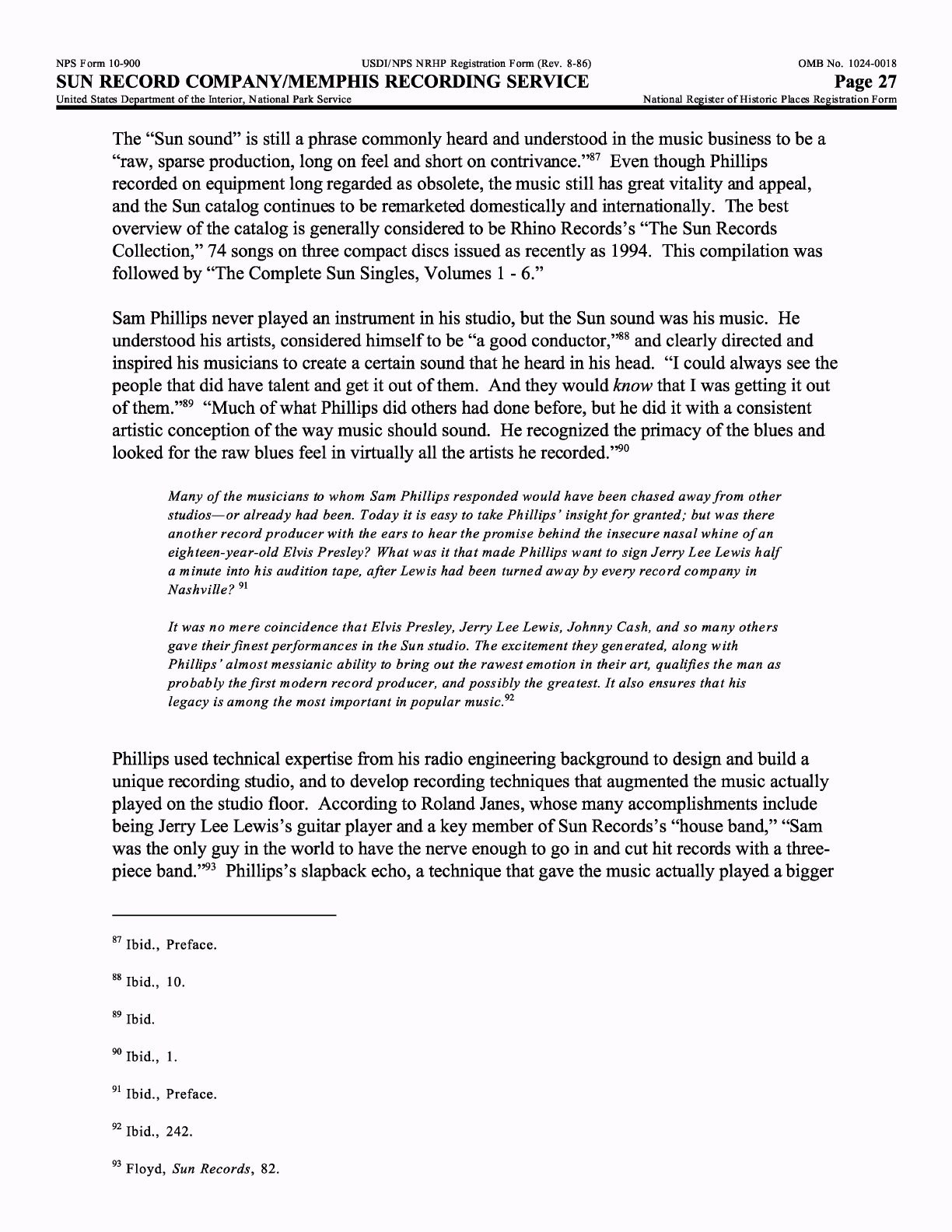
NFS
Form
10-900
USDI/NPS
NRHP
Registration
Form
(Rev. 8-86)
OMB
No.
1024-0018
SUN
RECORD COMPANY/MEMPHIS
RECORDING
SERVICE
Page
27
United
States
Department
of
the
Interior,
National
Park
Service
National
Register
of
Historic
Places
Registration
Form
The
"Sun
sound"
is
still
a
phrase
commonly
heard
and
understood
in
the
music
business
to
be
a
"raw,
sparse
production,
long
on
feel
and
short
on
contrivance."
87
Even
though
Phillips
recorded
on
equipment
long
regarded
as
obsolete,
the
music
still
has
great
vitality
and
appeal,
and
the
Sun
catalog
continues to
be
remarketed
domestically and
internationally.
The
best
overview
of
the
catalog
is
generally
considered
to
be
Rhino
Records's
"The
Sun
Records
Collection,"
74
songs
on
three
compact
discs
issued
as
recently
as
1994.
This
compilation
was
followed
by
"The
Complete
Sun
Singles,
Volumes
1
-
6."
Sam
Phillips
never played
an
instrument
in
his
studio,
but
the
Sun
sound
was
his
music.
He
understood
his
artists,
considered
himself
to
be
"a
good
conductor,"
88
and
clearly
directed
and
inspired
his
musicians
to
create
a
certain sound
that
he heard
in
his
head.
"I could
always
see
the
people
that
did have
talent
and
get
it
out
of
them.
And they
would
know
that
I
was
getting
it
out
of
them."
89
"Much
of
what
Phillips did
others
had
done
before,
but
he did
it
with
a
consistent
artistic
conception
of
the
way
music
should
sound.
He
recognized
the
primacy
of
the
blues and
looked
for
the
raw
blues
feel
in
virtually
all
the
artists
he
recorded."
90
Many
of
the
musicians
to
whom
Sam
Phillips
responded
would
have
been
chased
away
from
other
studios—or
already
had
been.
Today
it
is
easy
to
take
Phillips'
insight
for
granted;
but
was
there
another
record
producer
with
the
ears
to
hear
the
promise
behind
the
insecure
nasal
whine
of
an
eighteen-year-old
Elvis
Presley?
What
was
it
that
made
Phillips
want
to
sign
Jerry
Lee
Lewis
half
a
minute
into
his audition
tape,
after
Lewis
had
been
turned
away
by
every
record
company
in
Nashville?
91
It
was
no
mere
coincidence
that
Elvis
Presley,
Jerry
Lee
Lewis,
Johnny
Cash,
and
so
many
others
gave
their
finest
performances
in
the
Sun
studio.
The
excitement
they
generated,
along
with
Phillips'
almost
messianic
ability
to
bring
out
the
rawest
emotion
in
their
art,
qualifies
the
man
as
probably
the
first
modern
record
producer,
and
possibly
the
greatest.
It
also
ensures
that
his
legacy
is
among
the
most
important
in
popular
music.
92
Phillips
used
technical
expertise
from
his
radio
engineering
background
to
design
and
build
a
unique
recording
studio,
and
to
develop
recording
techniques
that
augmented
the
music
actually
played
on
the
studio
floor.
According
to
Roland
Janes,
whose
many
accomplishments
include
being
Jerry
Lee
Lewis's
guitar
player
and
a
key
member
of
Sun
Records's
"house
band,"
"Sam
was
the
only
guy
in
the
world
to
have
the
nerve
enough
to
go
in
and
cut
hit
records
with
a
three-
piece
band."
93
Phillips's
slapback
echo,
a
technique
that
gave
the
music
actually
played
a
bigger
87
Ibid.,
Preface.
88
Ibid.,
10.
89
Ibid.
90
Ibid.,
1.
91
Ibid.,
Preface.
92
Ibid.,
242.
Floyd,
Sun
Records,
82.

NFS
Form
10-900
USDI/NPS
NRHP
Registration
Form
(Rev. 8-86)
OMB
No.
1024-0018
SUN
RECORD COMPANY/MEMPHIS
RECORDING
SERVICE
Page
28
United
States
Department
of
the
Interior,
National
Park
Service
National
Register
of
Historic
Places
Registration
Form
sound
on
the
recording,
was
a
character-defining
feature
of
recordings made
at
706
Union.
He
obtained
the
echo
by
sending
the
signal
recorded
on
a
console
recorder
to
another recorder
mounted
on
the
wall
behind
his
head,
with
a
split-second
lag
in
between.
Phillips's
primary
goal
was
to
record
the
music
actually
played
in
his
studio,
to
capture
the
feeling
in
the
music,
because
"if
the
feeling
wasn't
there
on
the
floor
right
then.,
there
wasn't
any
point
in
doctoring
it
up
later."
94
Finally,
there
was
something
special
about
706
Union
Avenue
in
Memphis,
Tennessee,
the
place
itself
where
the
Sun
sound
was
created.
Many
artists
have
used
various
terms
to
describe
the
studio's
unique
atmosphere:
loose,
creative,
relaxed,
comfortable,
funky,
natural,
etc.
Some
have
said
that
the
place
had
magic,
but
others
scoffed
at
the
idea.
Whatever
it
was,
706
Union
Avenue
was
the
only
place
where
the
Sun
sound
was
created.
Record
companies
that
bought
Sun
artists
were
not
able
to
capture
the
same
sounds
and
feeling
that
Sam
Phillips
did,
even
though
they
used
his
recording
techniques.
The
Sun
sound did
not
even
follow
Phillips
himself
to
his
new
studio
on
Madison
Avenue.
The Sun
sound
was
a
unique
conjunction
of
people,
time,
and
place
that
proved
Sam
Phillips
to
be
a
visionary. It
made
age-old
walls
between
classes
and
races
come
tumbling
down,
and showed
that
music
was
a
powerful
art
that
could
change
the
world.
Sun
Records
in
Memphis.
The
bright
yellow
label
with
its
11
sunbeams.
Jerry
Lee
Lewis
and
his
Pumping
Piano.
Carl
Perkins
the
Rocking
Guitar
Man.
Rufus
"Bear
Cat"
Thomas.
And,
of
course,
Elvis
Presley,
the
original
Hillbilly
Cat.
That's
the
way the
credits
read,
and
it
all
sounds
curiously
old-fashioned
now.
But
if
the origin
of
a
music
can be
traced
to
any
one
source,
for
rock
'n'
roll
that
source
would
be
Sun.
And
if
there
is
one
man
without
whom
the
revolution
which
took
place
in
American
popular
music
seems
difficult
to
imagine,
that
man
is
Sam
Phillips.
Civil
Rights
Significance
Post
World
War
II
America
was
a
land
in
transition,
a
time
when
music
became
a
significant
cultural
force.
New
attitudes
toward
race
relations
accompanied
the
new
form
of
music,
rock
'n'
roll,
that
burst
forth
in
the
mid
1950s.
Some
changes
had
already
been
noted by
performers
and
followers
of
rhythm
and
blues
music,
but
racial barriers
really
began
to
fall
in
the
wake
of
rock
'n'
roll.
Younger
people,
particularly
in
the
South,
understood
that
the
new
music
had
roots
in
both
black
and
white musical
traditions.
The
new
youth
generation
embraced
the
new
music
not
only
because
it
moved
them
and
they
loved
it,
but
also
because
it
symbolized
freedom
and
defiance
of
the
status
quo.
The
role
of
music
as
an agent
of
social
and
political
change
was
recognized
long
ago.
"A
change
to
a
new
type
of
music
is
something
to
be
aware
of
as
a
hazard
of
all
our
fortunes.
For
the
modes
of
music
are
never
disturbed
without
[an]
unsettling
of
the
most
fundamental
political
and
social
conventions."
96
Rock
'n'
roll
opened
important
new
lines
of
communication.
It
brought
people
together
for
a
common
purpose
and
in
environments
that
promoted
racial
tolerance
and
understanding.
"Rock
94
Escott,
Good
Rockin'
Tonight,
224.
95
Guralnick,
Feel
Like
Going
Home,
171.
96
Michael
T.
Bertrand,
Race,
Rock,
and
Elvis
(Urbana
and
Chicago:
University
of
Illinois
Press,
2000),
17;
Quoting
Plato,
Republic,
in
Piero
Weiss
and
Richard
Taruskin,
eds.
Music
in
the
Western
World:
A
History
in
Documents
(New
York:
Schirmer
Books,
1984),
8.
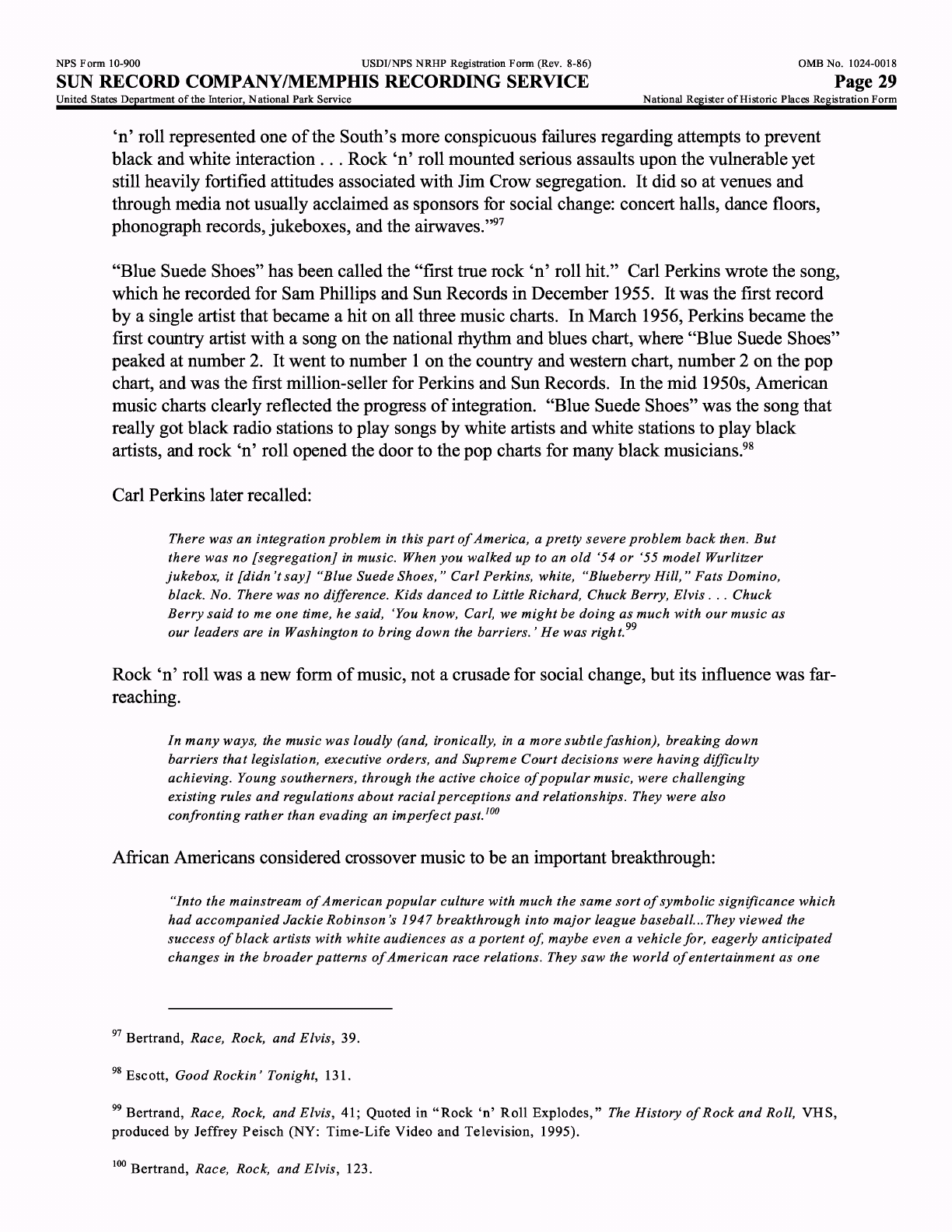
NFS
Form
10-900
USDI/NPS
NRHP
Registration
Form
(Rev. 8-86)
OMB
No.
1024-0018
SUN
RECORD COMPANY/MEMPHIS
RECORDING
SERVICE
Page
29
United
States
Department
of
the
Interior,
National
Park
Service
National
Register
of
Historic
Places
Registration
Form
'n'
roll
represented
one
of
the
South's
more
conspicuous
failures
regarding
attempts
to
prevent
black
and
white
interaction
..
.
Rock
'n'
roll
mounted
serious
assaults
upon
the
vulnerable
yet
still
heavily
fortified
attitudes
associated
with
Jim
Crow
segregation.
It
did
so
at
venues
and
through
media
not
usually
acclaimed
as
sponsors
for
social
change:
concert
halls,
dance floors,
phonograph
records,
jukeboxes,
and
the
airwaves."
97
"Blue
Suede
Shoes"
has
been
called
the
"first
true
rock
'n'
roll
hit."
Carl
Perkins
wrote
the
song,
which
he
recorded
for
Sam
Phillips
and
Sun
Records
in
December
1955.
It
was
the
first
record
by
a
single
artist
that
became
a
hit
on
all
three
music
charts.
In
March
1956,
Perkins
became
the
first
country artist
with
a
song
on
the
national
rhythm and
blues
chart,
where
"Blue
Suede
Shoes"
peaked
at
number
2.
It
went
to
number
1
on
the
country
and
western
chart,
number
2
on
the
pop
chart,
and
was
the
first
million-seller
for Perkins
and
Sun
Records.
In
the
mid
1950s,
American
music
charts
clearly
reflected
the progress
of
integration.
"Blue
Suede
Shoes"
was
the
song
that
really
got
black
radio
stations
to
play
songs
by
white
artists
and
white
stations
to
play
black
artists,
and
rock
'n'
roll
opened
the
door
to
the
pop
charts
for
many
black
musicians.
98
Carl
Perkins
later
recalled:
There
-was
an
integration
problem
in
this
part
of
America,
a
pretty
severe
problem
back
then.
But
there
was
no
[segregation]
in
music.
When
you
walked
up
to
an
old
'54
or
'55
model
Wurlitzer
jukebox,
it
[didn
't
say]
"Blue
Suede
Shoes,
"
Carl
Perkins,
white,
"Blueberry
Hill,
"
Fats
Domino,
black.
No.
There
was
no
difference.
Kids
danced
to
Little
Richard,
Chuck
Berry,
Elvis
. . .
Chuck
Berry
said
to
me
one
time,
he
said,
'You
know,
Carl,
we
might
be
doing
as
much
with
our
music
as
our
leaders
are
in
Washington
to
bring down
the
barriers.'
He
was
right.
Rock
'n'
roll
was
a
new
form
of
music,
not
a
crusade
for
social change,
but
its
influence
was
far-
reaching.
In
many
ways,
the
music was
loudly
(and,
ironically,
in
a
more
sub
tie
fas
hi
on),
breaking
down
barriers
that
legislation,
executive
orders,
and
Supreme Court
decisions
were
having
difficulty
achieving.
Young
southerners,
through
the
active
choice
of
popular
music,
were
challenging
existing
rules
and
regulations
about
racial
perceptions
and
relationships.
They
were
also
confronting
rather
than
evading
an
imperfect past.
100
African
Americans considered
crossover music
to
be
an
important
breakthrough:
"Into
the
mainstream
of
American
popular
culture
with
much
the
same
sort
of
symbolic
significance
which
had
accompanied
Jackie
Robinson's
1947
breakthrough
into
major
league baseball...
They
viewed
the
success
of
black
artists
with
white
audiences
as
a
portent
of,
maybe
even
a
vehicle
for,
eagerly
anticipated
changes
in
the
broader
patterns
of
American
race
relations.
They
saw
the
world
of
entertainment
as
one
97
Bertrand,
Race, Rock,
and
Elvis,
39.
98
Escott,
Good
Rockin'
Tonight,
131.
99
Bertrand,
Race, Rock,
and
Elvis,
41;
Quoted
in
"Rock
'n'
Roll
Explodes,"
The
History
of
Rock
and
Roll,
VHS,
produced
by
Jeffrey
Peisch
(NY:
Time-Life
Video
and
Television,
1995).
100
Bertrand,
Race, Rock,
and
Elvis,
123.
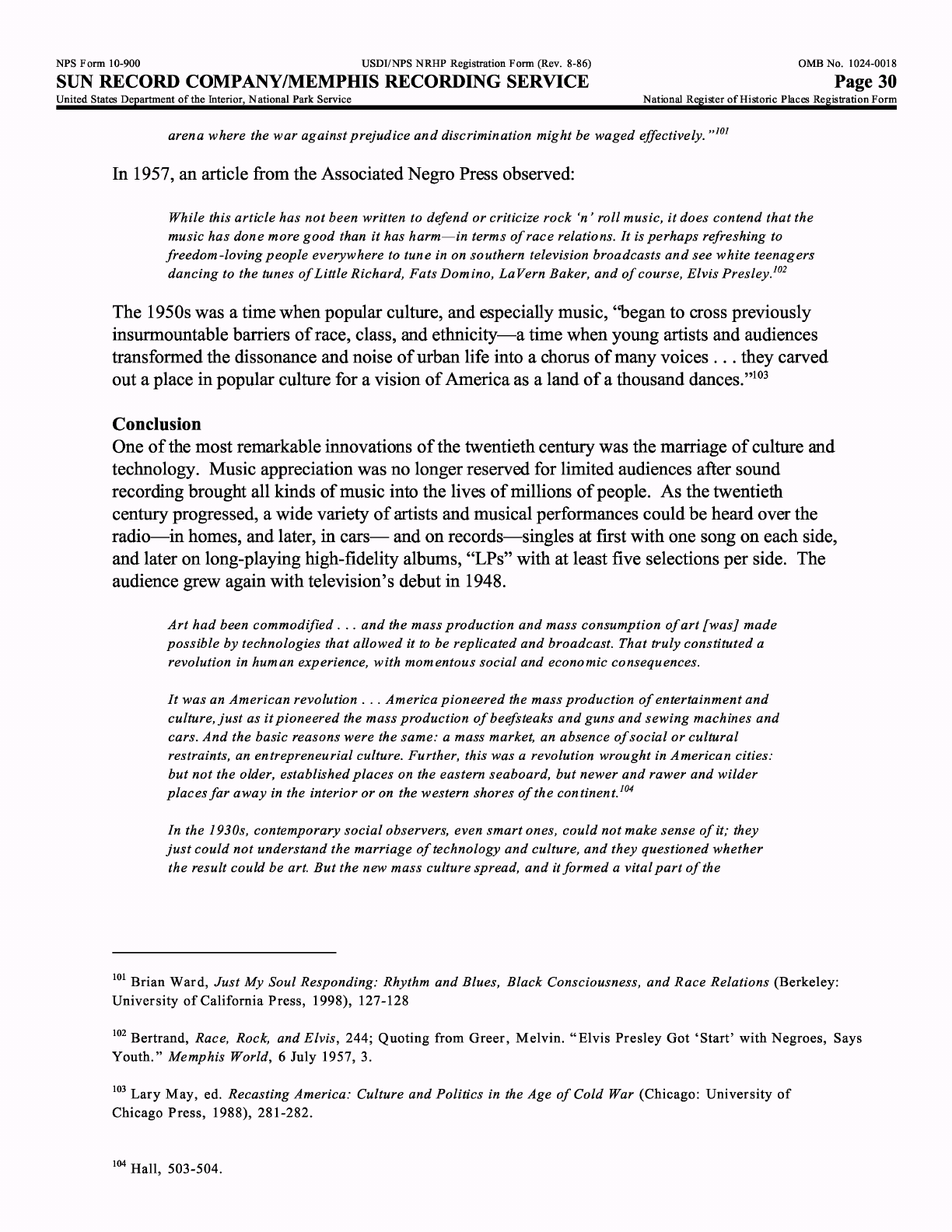
NFS
Form
10-900
USDI/NPS
NRHP
Registration
Form
(Rev. 8-86)
OMB
No.
1024-0018
SUN
RECORD COMPANY/MEMPHIS
RECORDING
SERVICE
Page
30
United
States
Department
of
the
Interior,
National
Park
Service
National
Register
of
Historic
Places
Registration
Form
arena
-where
the
war
against
prejudice
and
discrimination
might
be
waged
effectively.
"
m
In
1957,
an
article
from
the
Associated
Negro
Press
observed:
While
this
article
has
not
been
written
to
defend
or
criticize
rock
'n'
roll
music,
it
does
contend
that
the
music has
done
more
good
than
it
has
harm—in
terms
of
race
relations.
It
is
perhaps
refreshing
to
freedom-loving
people
everywhere
to
tune
in
on
southern
television
broadcasts
and
see
white
teenagers
dancing
to
the
tunes
of
Little
Richard,
Fats
Domino,
LaVern
Baker,
and
of
course,
Elvis
Presley.
102
The
1950s
was
a
time
when
popular
culture,
and
especially
music,
"began
to
cross
previously
insurmountable
barriers
of
race,
class,
and
ethnicity—a
time
when
young
artists
and
audiences
transformed
the
dissonance
and noise
of
urban
life
into
a
chorus
of
many
voices
.
.
.
they
carved
out
a
place
in
popular
culture
for
a
vision
of
America
as
a
land
of
a
thousand
dances."
103
Conclusion
One
of
the
most
remarkable
innovations
of
the
twentieth
century
was
the
marriage
of
culture
and
technology.
Music
appreciation
was
no
longer
reserved
for
limited
audiences
after
sound
recording
brought
all
kinds
of
music
into
the
lives
of
millions
of
people.
As
the
twentieth
century
progressed,
a
wide
variety
of
artists
and
musical
performances
could
be
heard
over
the
radio—in
homes,
and
later,
in
cars—
and
on
records—singles
at
first
with
one
song
on
each
side,
and
later
on
long-playing
high-fidelity
albums,
"LPs"
with
at
least
five
selections
per
side.
The
audience
grew again
with
television's
debut
in
1948.
Art
had
been
commodified
. . .
and
the
mass
production
and
mass
consumption
of
art
[was]
made
possible
by
technologies
that
allowed
it
to
be
replicated
and
broadcast.
That
truly
constituted
a
revolution
in
human
experience,
with
momentous
social
and
economic consequences.
It
was
an
American
revolution
. . .
America
pioneered
the
mass
production
of
entertainment
and
culture,
just
as
it
pioneered
the
mass
production
of
beefsteaks
and
guns
and
sewing
machines
and
cars.
And
the
basic
reasons
were
the
same:
a
mass
market,
an
absence
of
social
or
cultural
restraints,
an
entrepreneurial
culture.
Further,
this
was
a
revolution
wrought
in
American
cities:
but not
the
older,
established
places
on
the
eastern
seaboard,
but
newer
and
rawer
and
wilder
places
far
away
in
the
interior
or
on
the
western
shores
of
the
continent.
104
In
the
1930s,
contemporary
social
observers,
even
smart
ones,
could
not
make
sense
of
it;
they
just
could
not
understand
the
marriage
of
technology
and
culture,
and
they
questioned
whether
the
result
could
be
art.
But
the
new
mass
culture
spread,
and
it
formed
a
vital
part
of
the
101
Brian
Ward,
Just
My
Soul
Responding:
Rhythm
and
Blues,
Black
Consciousness,
and
Race
Relations
(Berkeley:
University
of
California
Press,
1998),
127-128
102
Bertrand,
Race, Rock,
and
Elvis,
244;
Quoting
from
Greer,
Melvin.
"Elvis
Presley
Got
'Start'
with
Negroes,
Says
Youth."
Memphis
World,
6
July
1957,
3.
103
Lary
May,
ed.
Recasting
America:
Culture
and
Politics
in
the
Age
of
Cold
War
(Chicago:
University
of
Chicago
Press,
1988),
281-282.
104
Hall,
503-504.

NFS
Form
10-900
USDI/NPS
NRHP
Registration
Form
(Rev. 8-86)
OMB
No.
1024-0018
SUN
RECORD COMPANY/MEMPHIS
RECORDING
SERVICE
Page
31
United
States
Department
of
the
Interior,
National
Park
Service
National
Register
of
Historic
Places
Registration
Form
homogenization
of
America:
it
tied
the
country
together,
just
as
railroads
and
highways
and
the
Roosevelt
presidency
did.
105
Like
the
birth
of
motion
pictures
in
Hollywood
between
1910
and
1925,
the
birth
of
modern
popular
music
in
Memphis
between
1947
and
1956
was
the
birth
of
a
popular
art.
It
was
created
bottom-up,
by
outsiders
who
took
that
art
from
folk
traditions
bred
in
poverty,
the
most
abject
poverty
America
had
known.
There
is no
previous
parallel
at
all
in
the
history
of
music
.
..
For
this was
a
music
created
by
a
desperately
poor
and
exploited
underclass,
which
became
transformed
by
degrees
as
it
was
exported
to
America
's
cities.
The
change
could
have
occurred
in
a
number
of
cities
. . .
[but]
it was
most
likely
to
happen
in
Memphis,
because
Memphis
was
the
point
of
confluence
of
different
traditions;
because
it
was
such
a
free-and-easy
place;
and
because
it
contained
a
new
group
of
entrepreneurs,
who
understood
both
traditions.
Memphis
innovated
while
the
New
York-Hollywood
axis,
established
entertainment capital
of
America,
resisted
innovation
. . .
Memphis
then
became
the
first
example
of
a
real
social
revolution
in
art:
not
the
imitation
of
primitive
originals
by
sophisticated
metropolitan
artists,
as
in
Paris
at
the
turn
of
the
century,
but
the
victory
of
the
art
of
the
underclass
and
of
its
underclass
performers,
and
eventually
of
its
values.
106
Such
huge
innovative
capacity
does
not come
easily.
It
can
only
happen
in
a
society
in
extreme
flux,
where
new
socio-economic
or ethnic
groups
are
defining
themselves
and
asserting
themselves.
New
York
in
1900,
America's
quintessential
immigrant
city,
was
one
such;
Memphis
in
1950,
the
city
where
rural
migration
streams
met
on
the
eve
of
the
cotton
picking
machine
and
of
the
civil
rights
era,
was
another.
107
What
the
Memphis
story
finally
shows
is
that
the
music
of
an
underclass
could
literally
become
the
music
of
the
world.
That
represented
the
final
breaching
of
the
dam,
which
nineteenth-
and
early
twentieth-century
bourgeois
society
had
erected,
to
try
to
exclude
a
form
of
expression
that
it
regarded
as
menacing
to
mainstream
values.
It
was
part
and
parcel
of
a
general
breakdown
of
all
such
barriers,
those
of
race
and
class
and
geography,
that
came
with
increasing
mobility
and
increasing
diffusion
of
different
cultures;
it
was
an
important
part
of
the
creation
of
the
multi-
cultural
society
of
the
late
twentieth
century,
in
which
America
has
played
such
a
large
part.
108
Music
has
long
been
one
of
the
South's
greatest
resources,
an
invaluable
export,
and
a
powerful
connection
to
the
rest
of
the
world.
And
even
though
southern literature
is
generally
regarded
as
"the
hallmark
of
southern
culture,...
it
is
music,
rather
than
literature,
that
remains
the
South's
most
characteristic
and
enduring
achievement."
109
105
Ibid.,
517.
106
Ibid.,
605-606.
107
Ibid.,
607.
108
Ibid.,
602.
109
Vernon
Chadwick,
ed.,
In
Search
of
Elvis:
Music:
Race,
Art,
Religion
(Boulder,
Colorado:
Westview
Press,
1997),
xvii.
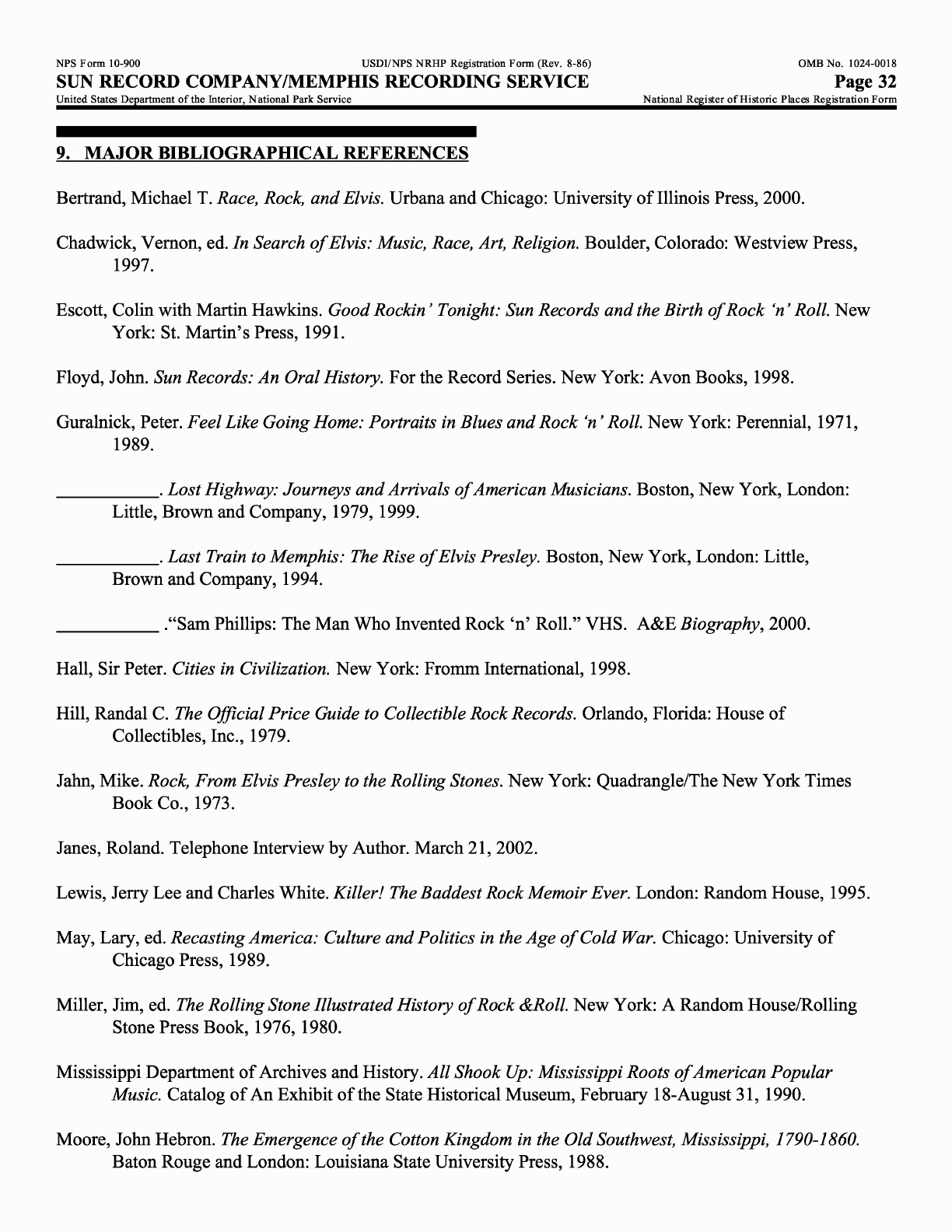
NFS
Form
10-900
USDI/NPS
NRHP
Registration
Form
(Rev. 8-86)
OMB
No.
1024-0018
SUN
RECORD COMPANY/MEMPHIS
RECORDING
SERVICE
Page
32
United
States
Department
of
the
Interior,
National
Park
Service_____________________________________National
Register
of
Historic
Places
Registration
Form
9.
MAJOR
BIBLIOGRAPHICAL
REFERENCES
Bertrand,
Michael
T.
Race,
Rock,
andElvis.
Urbana
and
Chicago:
University
of
Illinois
Press,
2000.
Chadwick, Vernon,
ed.
In
Search
ofElvis:
Music,
Race,
Art,
Religion.
Boulder,
Colorado:
Westview
Press,
1997.
Escort,
Colin
with
Martin
Hawkins.
Good
Rockin'
Tonight:
Sun
Records
and
the
Birth
of
Rock
'n'
Roll
New
York:
St.
Martin's
Press,
1991.
Floyd,
John.
Sun
Records:
An
Oral
History.
For
the
Record
Series.
New
York:
Avon
Books,
1998.
Guralnick,
Peter.
Feel
Like
Going
Home:
Portraits
in
Blues
and
Rock
'n'
Roll.
New
York:
Perennial,
1971,
1989.
_______.
Lost
Highway:
Journeys
and
Arrivals
of
American
Musicians.
Boston,
New
York,
London:
Little,
Brown
and
Company,
1979,
1999.
___.
Last
Train
to
Memphis:
The
Rise
ofElvis
Presley.
Boston,
New
York,
London: Little,
Brown
and
Company,
1994.
___
."Sam
Phillips:
The
Man
Who
Invented
Rock
'n'
Roll."
VHS.
A&E
Biography,
2000.
Hall,
Sir
Peter.
Cities
in
Civilization.
New
York:
Fromm
International,
1998.
Hill,
Randal
C.
The
Official
Price
Guide
to
Collectible
Rock
Records.
Orlando,
Florida:
House
of
Collectibles,
Inc.,
1979.
Jahn, Mike.
Rock,
From
Elvis
Presley
to
the
Rolling
Stones.
New
York:
Quadrangle/The
New
York
Times
Book
Co.,
1973.
Janes,
Roland.
Telephone
Interview
by
Author.
March
21,
2002.
Lewis,
Jerry
Lee
and
Charles
White.
Killer!
The
Saddest
Rock
Memoir
Ever.
London:
Random
House,
1995.
May,
Lary,
ed.
Recasting
America:
Culture
and
Politics
in
the
Age
of
Cold
War.
Chicago:
University
of
Chicago
Press,
1989.
Miller,
Jim,
ed.
The
Rolling
Stone
Illustrated
History
of
Rock
&Roll.
New
York:
A
Random
House/Rolling
Stone
Press
Book,
1976,
1980.
Mississippi
Department
of
Archives
and
History.
All
Shook
Up:
Mississippi
Roots
of
American
Popular
Music.
Catalog
of
An
Exhibit
of
the
State
Historical
Museum,
February
18-August
31,
1990.
Moore,
John
Hebron.
The
Emergence
of
the
Cotton
Kingdom
in
the
Old
Southwest,
Mississippi,
1790-1860.
Baton
Rouge
and
London:
Louisiana
State
University
Press,
1988.
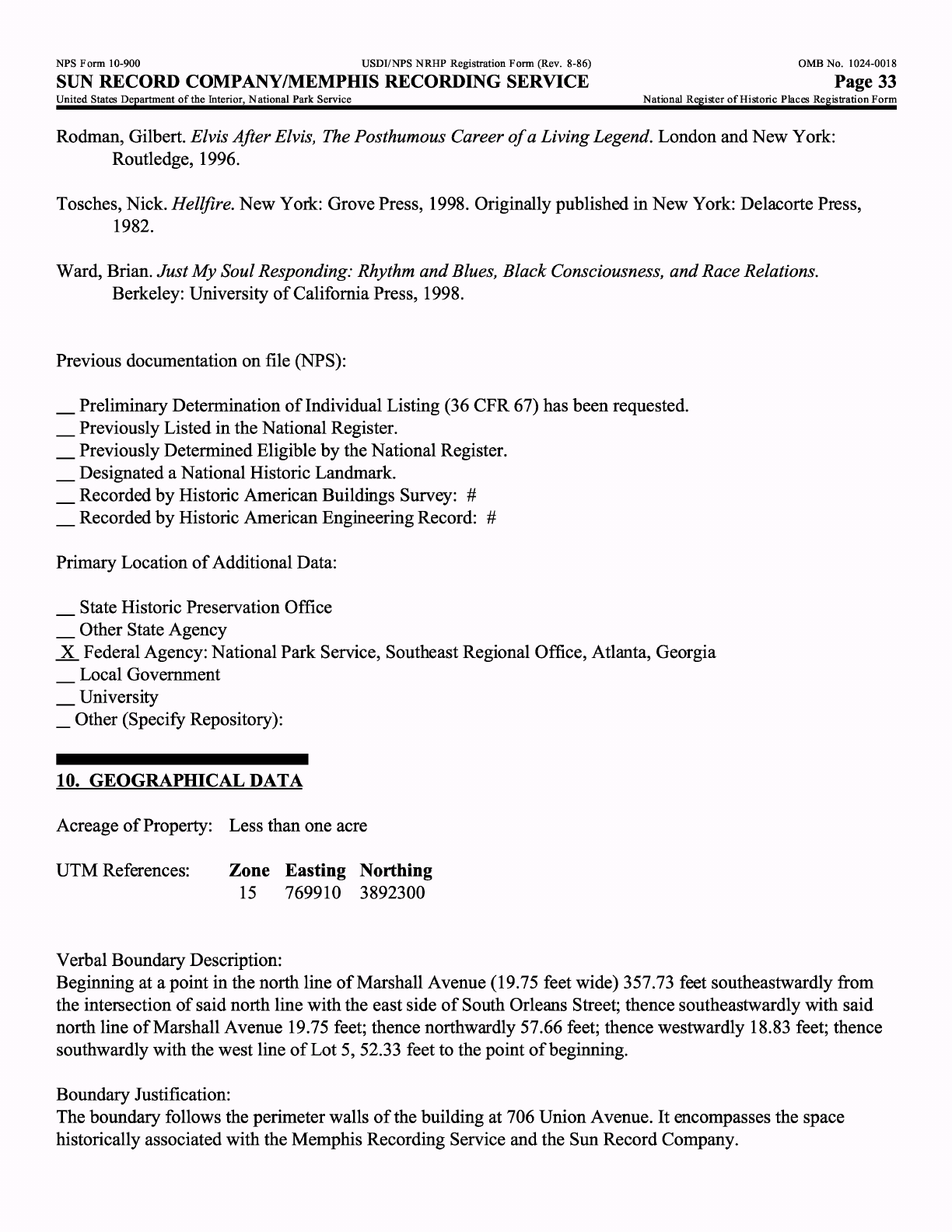
NFS
Form
10-900
USDI/NPS
NRHP
Registration
Form
(Rev. 8-86)
OMB
No.
1024-0018
SUN
RECORD COMPANY/MEMPHIS
RECORDING
SERVICE
Page
33
United
States
Department
of
the
Interior,
National
Park
Service
National
Register
of
Historic
Places
Registration
Form
Rodman,
Gilbert.
Elvis
After
Elvis,
The
Posthumous
Career
of
a
Living
Legend.
London
and
New
York:
Routledge,
1996.
Tosches,
Nick.
Hellfire.
New
York:
Grove
Press,
1998.
Originally
published
in
New
York:
Delacorte
Press,
1982.
Ward,
Brian.
Just
My
Soul
Responding:
Rhythm
and
Blues,
Black
Consciousness,
and
Race
Relations.
Berkeley:
University
of
California
Press,
1998.
Previous
documentation
on
file
(NFS):
_
Preliminary
Determination
of
Individual
Listing
(36
CFR
67)
has
been
requested.
_
Previously
Listed
in
the
National
Register.
_
Previously
Determined
Eligible
by
the
National
Register.
_
Designated
a
National
Historic
Landmark.
_
Recorded
by
Historic
American
Buildings
Survey:
#
__
Recorded
by
Historic
American
Engineering
Record:
#
Primary
Location
of
Additional
Data:
_
State
Historic
Preservation
Office
_
Other
State
Agency
X
Federal
Agency:
National
Park
Service,
Southeast
Regional
Office,
Atlanta,
Georgia
_
Local
Government
_
University
_
Other
(Specify
Repository):
10.
GEOGRAPHICAL
DATA
Acreage
of
Property:
Less
than
one
acre
UTM
References:
Zone
Easting
Northing
15
769910
3892300
Verbal
Boundary
Description:
Beginning
at
a
point
in
the
north
line
of
Marshall
Avenue
(19.75
feet
wide)
357.73
feet
southeastwardly
from
the
intersection
of
said north
line
with
the
east
side
of
South
Orleans
Street;
thence
southeastwardly
with said
north
line
of
Marshall
Avenue
19.75
feet;
thence
northwardly
57.66
feet;
thence
westwardly
18.83
feet;
thence
southwardly
with
the
west
line
of
Lot
5,
52.33
feet
to
the
point
of
beginning.
Boundary
Justification:
The
boundary
follows
the
perimeter
walls
of
the
building
at
706
Union
Avenue. It encompasses the
space
historically
associated
with
the
Memphis
Recording
Service
and
the
Sun
Record
Company.
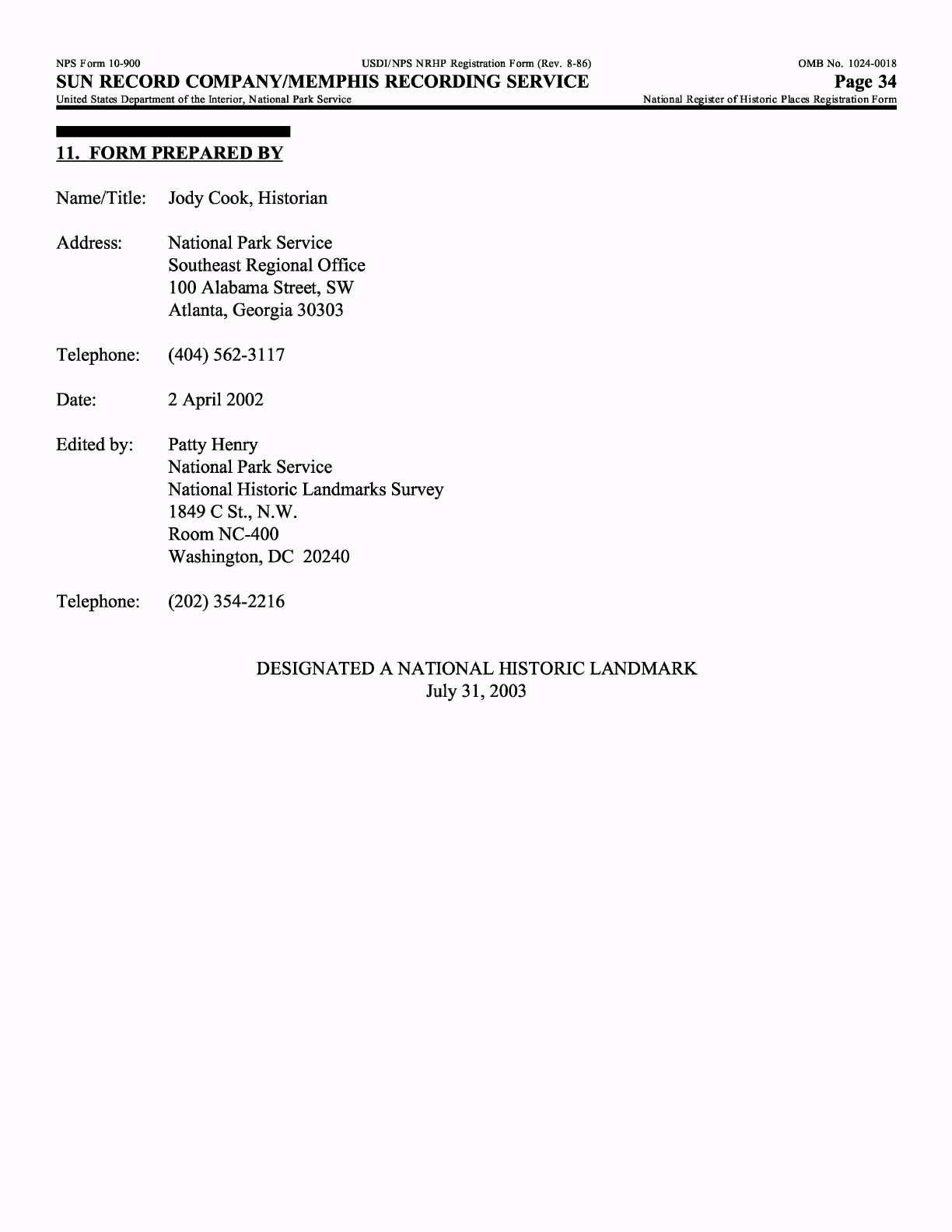
NFS
Form
10-900
USDI/NPS
NRHP
Registration
Form
(Rev. 8-86)
SUN
RECORD COMPANY/MEMPHIS
RECORDING
SERVICE
United
States
Department
of
the
Interior,
National
Park
Service_______________________________
OMBNo.
1024-0018
Page
34
National
Register
of
Historic
Places
Registration
Form
11.
FORM
PREPARED
BY
Name/Title:
Jody
Cook,
Historian
Address:
National
Park
Service
Southeast
Regional
Office
100
Alabama
Street,
SW
Atlanta,
Georgia
30303
Telephone:
(404)
562-3117
Date:
2
April
2002
Edited
by:
Patty
Henry
National
Park
Service
National
Historic
Landmarks
Survey
1849CSt.,N.W.
RoomNC-400
Washington,
DC
20240
Telephone:
(202)
354-2216
DESIGNATED
A
NATIONAL
HISTORIC
LANDMARK
July
31,2003
